MONDAY
SEPTEMBER 30 - 2013
EMSWORTH
HARBOUR
Nore
Barn - 12:00
About 3 hours after high water. The Greenshank was in
the stream along with the Little Egret, both regulars
this autumn. 5 Mute Swans in the channel.
104 Black-tailed
Godwits assembled on the western mudflat. By 12.45
many of the godwits had moved onto the mudflats either
side of the Emsworth Sailing Club building. Three
colour-ringed birds.
G+WR - 4th sighting this autumn.
G+BY - Second sighting this season.
G+BG - First sighting this summer. A regular
over the past 4 winters.
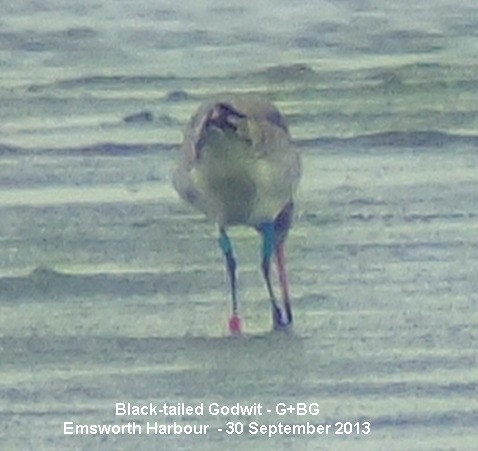
One Greenshank -
GY+YY - My first ever sighting. Possibly one of
the newly ringed birds?
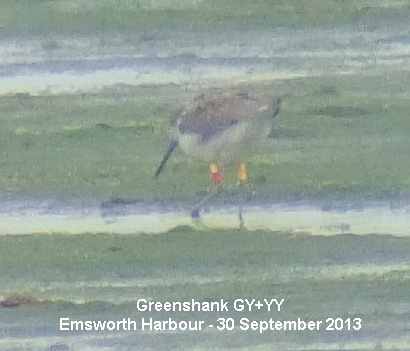
BROOK
MEADOW
Annual
cut
Martin Cull was doing
his second cut of the meadow when I went over this
afternoon. I had no idea he was coming; he said it was
a last minute arrangement. He had already finished the
Lumley area and the northern part of the orchid area
and was working on the uncut part of the centre
meadow. I was particularly pleased to see the Lumley
area cut as this is our best area for sedges and
rushes and was not cut at all last year. Martin said
he would be pleased to return to cut the remaining
areas if the conservation group requested.
Here
is Martin at work with the already cut Lumley area in
the background.
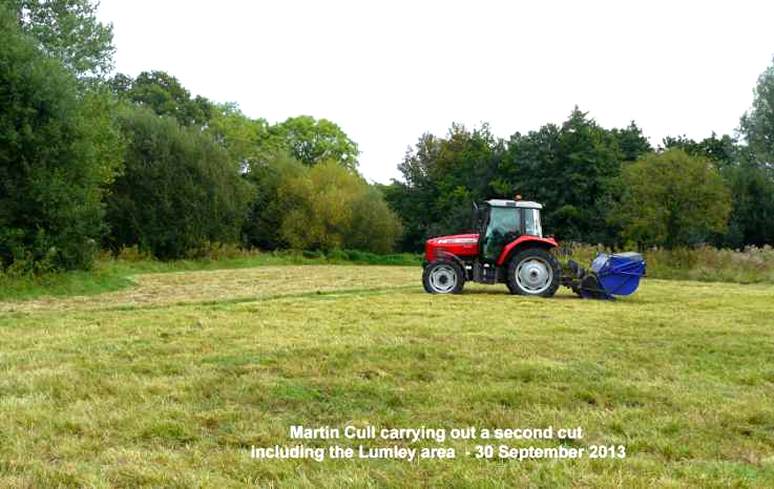
Plants
I found just one plant
of Pepper-saxifrage that had escaped Martin's
cutters on the east side of the Lumley area, but as
the plants are perennials they should be back again
next year. The first of the Michaelmas Daisies
is now open on the Bramble path. Some of the
grasses are starting to flower again, False
Oat-grass, Tall Fescue and Cocksfoot. There are also
fresh flowers on the Hogweed.
Water
Vole
After a couple of
weeks of intense searching Malcolm Phillips at last
spotted a Water Vole on the north bank near the
railway embankment. He got this very fine image of the
animal. Does anyone take better Water Vole pictures
than Malcolm I wonder?
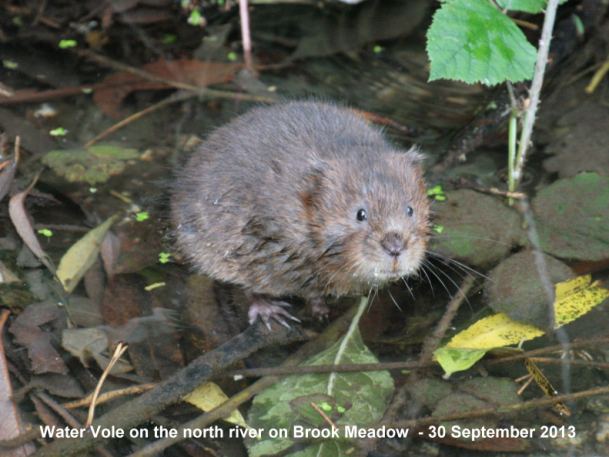
Chiffchaff
Malcolm also captured
a lingering Chiffchaff in the north-east corner of the
meadow. This could possibly be one of those that spend
the winter with us.
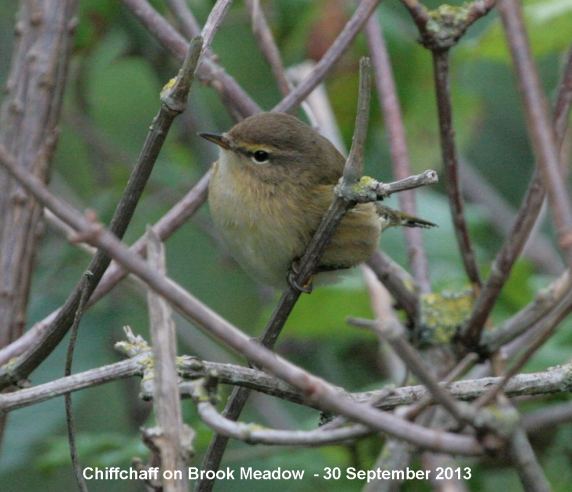
Millpond
Swans
Last Friday (Sep 27) I
met Ralph Hollins at Nore Barn and we discussed when,
if ever, the Mute Swan pair that nested this year at
the northern end of the pond might cease to defend
their nest site to allow the flock of non-breeding
swans back onto the pond. Ralph expressed the opinion
that as there was a distinct housing shortage for
Swans - far more birds of breeding age than suitable
nest sites - and that as Swans pair for life, and live
a long time, any pair with a good nest site will
defend it year round to ensure its availability next
spring. If this is the case then the prospects for a
return of the large Mute Swan flock to the millpond
appear to be slim. See Ralph's diary for Fri 27 Sep .
. . http://ralph-hollins.net/Diary.htm
As I was passing this
morning I saw a flotilla of 13 Mute Swans in
the harbour below the millpond seawall, presumably
hoping to be allowed onto the pond. But not yet I
suspect.
Thorney
news
On Saturday (Sep 28)
Barry Collins reported 2,000 Brent Geese on the
mudflats off the southern end of Thorney Island. At
Pilsey Sands throughout the morning there was a steady
movement of at least 500 Swallows all flying E.
There was also an Osprey on a wooden structure out on
the mudflats yesterday afternoon.
On Sunday (Sep 29)
Barry reported the Osprey with primaries
missing on the right wing was perched on a wooden
structure on Pilsey Sands at 10.15. Then at 10.50 it
made several attempts to catch a fish before finally
catching one and then flew W over to the mudflats near
Marker Point at 11.20. On a falling tide 22 Harbour
Seals hauled their selves up on to the mudflats of
the southern end of Thorney Island. Butterflies
of note included 4 Clouded Yellows and 5 Red Admirals.
SATURDAY
SEPTEMBER 28 - 2013
Water
Voles in Havant
Malcolm Phillips could
not find any Water Voles on Brook Meadow, so he went
over to Havant where he found at least three in the
small pond in front of the old Dolphin pub. Here is
one of the photos he send me. A cracker.

Water Voles have been
seen frequently here this summer - probably for the
first time ever? Ralph Hollins thinks they are not
resident breeders, but are wanderers from some, as
yet, unknown birthplace (most likely on the banks of
the Langbrook Stream).
Sparrowhawk
takes Goldfinch
Patrick Murphy watched
an interesting confrontation this afternoon in his
garden between a juvenile Sparrowhawk with a Goldfinch
in its talons and a Magpie. Patrick said the hawk
didn't move, but just kept a beady eye on the Magpie
even though it got to within about 18 inches. Finally,
the Sparrowhawk made off with its meal.
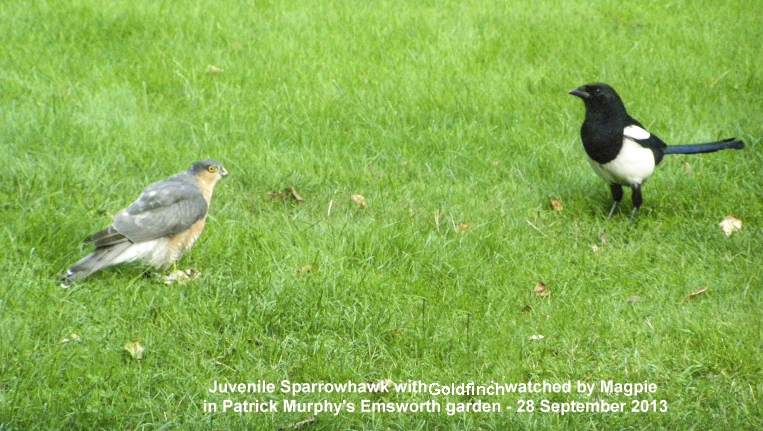
FRIDAY
SEPTEMBER 27 - 2013
Emsworth
Harbour
10:30 - 11:30 - Tide
falling to low water at about 11:00. 48 Black-tailed
Godwits in eastern harbour. I checked about 20 for
colour-rings, found one. L+LL - My second sighting
this season. A regular in Emsworth Harbour since
06-Nov-09.
Here is a digiscoped
image of Black-tailed Godwit L+LL in poor light. Left
leg has lime L ring on tibia and red R on tarsus
(ankle). Right leg has two lime rings on tibia. All
Farlington godwits have a red ring on the left tarsus
so that is usually not reported. The photo also shows
the metal BTO ring on the right ankle.
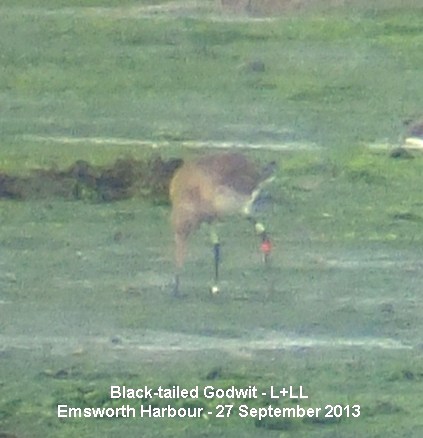
Others included 12
Turnstones - the most so far this autumn and 4
Greenshank - including RG+BY geo which was also here
yesterday.
Nore
Barn
15:00 - About 2 hours
to high water. Greenshank and Little Egret in the
stream, plus 7 Mute Swans. In the main channel were
two Shelduck - the first of the season,
probably local breeders rather than migrants from
North Germany, according to Ralph Hollins who was
passing. One (partially under water in the photo)
appeared to be moulting.

Also, in the channel
were a few Teal and Wigeon. About 30 Oystercatchers
were on the edges of the channels.
Tamarisk was flowering in front of the reedbeds
at Nore Barn. The photo shows a ginger Bumblebee
feeding on the flowers. This is probably Bombus
pascuorum which is the most common of the
ginger Bumblebees.

Beacon
Square fungi
Beacon Square is well
known for its fungi. I found several fungi on the
grass verge on the southern side today. This one is
easily identified as a Roll-rim from the inrolled
edges of the cap - probably Brown Roll-rim
(Paxillus involutus) which is the more
common of the Roll-rims.
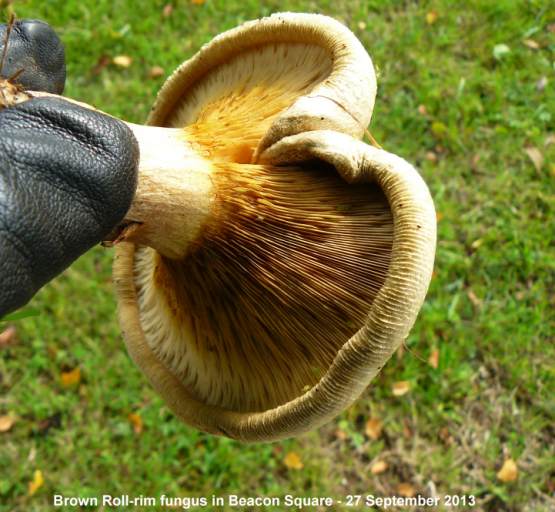
The others were
Boletes, but as yet unidentified. Possibly Brown
Birch Bolete. See photo.
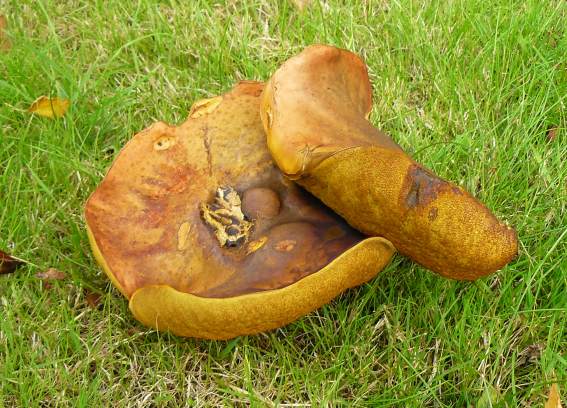
OTHER
NEWS
Slow-worm
recovery
Peter Milinets-Raby
has been removing Slow-worms from a demolition site in
Denvilles. He sent me this image of one of them
emerging from under one of the mats.
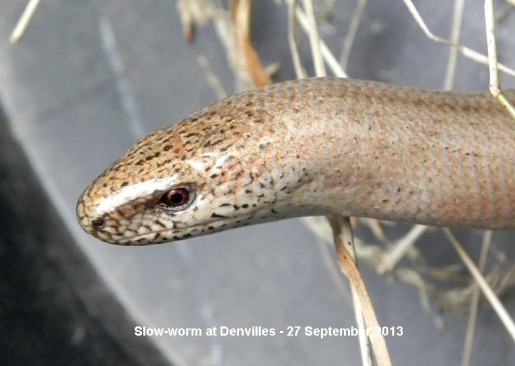
Peter also found this
grasshopper sunning itself on top of one of the mats.
It looks like a Meadow Grasshopper - probably a
male from its relatively long wings.

Meadow Grasshoppers
are the only flightless grasshopper in Britain. In
females the wing cases (covering vestigial wings)
extend only a short way down the abdomen while males
have longer wing cases extending to almost the tip of
the abdomen, but are not adequate for flying. So they
just hop!
See . . . http://en.wikipedia.org/wiki/Chorthippus_parallelus
Brent
Geese arrive
Chris Cockburn
reported large numbers of dark-bellied Brent geese
arrived in Langstone Harbour on Sep 26. Today he
counted 1081 feeding off the West Hayling shore . They
included one group of 247 birds of which 9 were
youngsters (broods of 3, 2, 2, 1 and 1). See Chris's
full report below.
Hayling
Oysterbeds news
Chris Cockburn reports
on the end of the seabird breeding season.
"The breeding season
is finally finished following the last common tern
youngster fledging on 17 Sep - and here's wishing it
the best of luck - it will certainly need plenty of
luck if it is to survive the trip to W Africa. So,
final common tern result was 57 fledged youngsters
from 73 pairs.
Meanwhile, numbers are
getting higher for passage and over-wintering waders
and wildfowl. At the Oysterbeds, oystercatcher roosts
are frequently greater than 1000 birds - it's quite a
sight when the whole flock moves! Good numbers of
ringed plovers and dunlins are sometimes roosting on
the imported shingle at the western end of the NW
Bund. Hopefully, the vegetation will be cleared soon
and we should see some very good small-wader roosts
during the big spring tides (and there might even be a
chance of a returning shorelark!)
Yesterday, 26 Sep, saw
the arrival of large numbers of dark-bellied Brent
geese and widgeons (there were at least 1500 widgeons
in the harbour yesterday - but many of these birds are
transient and will be moving westwards soon. Today,
there were 1081 Brent geese feeding off the West
Hayling shore and the flocks included one group of 247
birds of which 9 were youngsters (broods of 3, 2, 2, 1
and 1). There was also a male red-breasted goose with
the Brent - presumably the bird that was at Farlington
in the spring. An osprey was today seen eating a fish
on one of the Sinah Lake marker posts.
There are still a
surprising number of white butterflies, particularly
on the Billy Trail, also a few Speckled Woods &
Small Coppers and a Comma. Oh and the blackberries are
tasting good!"
THURSDAY
SEPTEMBER 26 - 2013
EMSWORTH
MILLPOND
Alex Maxted e-mailed
me asking if I knew anything about
the
little white duck
that has recently appeared on the millpond. White
ducks often appear on the millponds and I assume they
are some domestic breed and have escaped from a
collection somewhere or have been released onto the
pond as unwanted pets. Who knows? They occasionally
interbreed with the Mallards, producing the strange
mixed hybrids we sometimes see on the
ponds.

I counted 98 Mallards
on the millpond this morning, which is about the norm
for this time of the year. Clearly, they have not been
put off by the resident Mute Swans.
The
Mute Swan pair were
both defending their territory again this morning from
four swans that had ventured onto the pond. The four
did not last long as they were quickly driven off. So,
the pond remains empty of swans, but for the 'litter
nest' family.
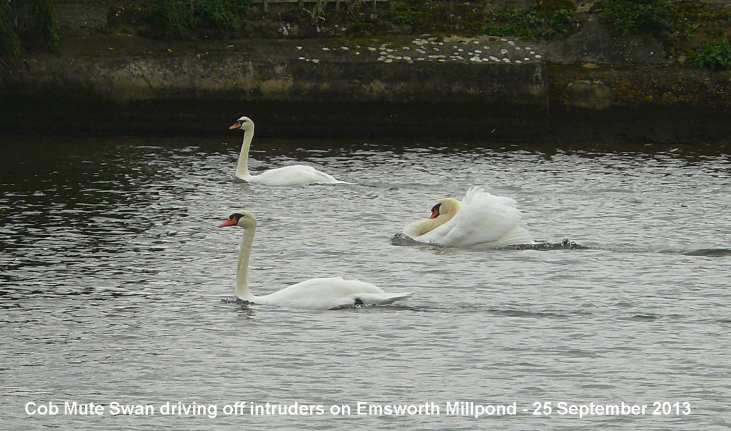
The
cygnet from the 'litter nest'
that started
off so poorly, is now looking fine and healthy.
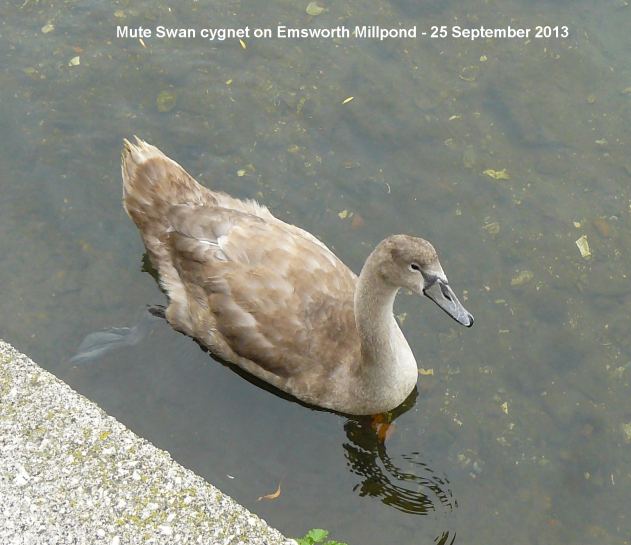
EMSWORTH
HARBOUR
11:30 - 12.30 - Tide
rising to high water at 16:30.
80
Black-tailed Godwits
- two were colour-ringed, both first sightings this
season.
G+GY - Ringed Farlington 14-Sep-05. First
sighting in Emsworth on 27-Oct-06. Seen in most
winters in Emsworth Harbour, but not a mega regular.
This was my 13th sighting in Emsworth.
W+WN - Ringed 05-Sep-10 Farlington Marshes.
First seen in Emsworth Harbour the following month on
18-Oct-10. It was a mega regular in Emsworth in winter
2011-12 with 41 sightings. But I only saw it once last
winter on 17-Jul-12.
4
Greenshank -
one was colour-ringed:
RG+BY geo - This is one of 3 Greenshanks that
Pete Potts caught at Thorney and fitted geolocators to
the blue rings. I previously saw it here on 12-Jul-13.
The geo tab shows up clearly on this photo.

There has been a
big
influx of Redshank
since yesterday - I counted 120. They probably
included some of those that Peter Milinets-Raby found
missing from the Warblington shore Also, 30 Dunlin, 4
Curlew, 10+ Oystercatcher, 10 Turnstone, 2 Little
Egret, 2 Grey Heron.
OTHER
NEWS
Fungi
in Stansted Forest
This is a good time of
the year to see fungi and there is no better place
locally than Stansted Forest to get a good selection
of species. Jill Stanley enjoyed a walk through this
fine woodland yesterday and obtained some excellent
images of fungi, including these two beauties.
Magpie
Ink Cap - gets its name from the the pattern on the
cap
and the fact that the whole plant quickly dissolves
into a black inky substance.

Porcelain
Fungus - there is no mistaking this one.
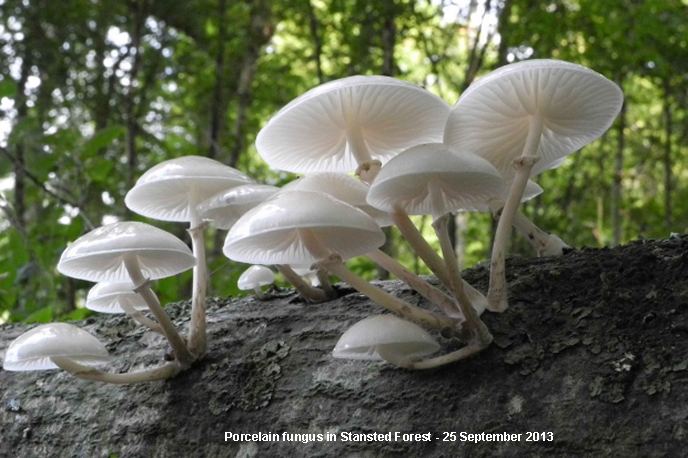
House Sparrow recovery
During the last few
decades, the population of British House Sparrows has
declined by roughly half, but the latest data from the
British Trust for Ornithology's (BTO) Garden BirdWatch
indicates the decline is levelling off in gardens. The
decline of the House Sparrow has been dramatic,
falling from around 12 million British pairs in the
1970s to between six and seven million pairs
currently, with a greater reduction in population size
in urban and rural areas, than in suburban ones.
The reasons behind the
decline very much depend on population location, as
House Sparrows are fairly sedentary birds. Populations
across Britain were affected by loss of nesting sites
and food sources, especially the lack of invertebrates
to feed their young. However, in rural areas, changes
in farming practices are thought to have had a large
effect but in urban and suburban populations causes
were more complex and may have included increased
competition with other birds and increased pesticide
use in gardens.
See . . . http://www.bto.org/news-events/press-releases/good-news-house-sparrows
WEDNESDAY
SEPTEMBER 25 - 2013
EMSWORTH
HARBOUR
12:30 - Eastern
harbour. About 3 1/2 hours to high water. Viewing from
the millpond seawall.
I counted 52
Black-tailed Godwits resting on the edge of the
channel. They included three colour-ringed birds:
G+WR - 4th sighting this season. A very regular
wintering bird in Emsworth Harbour since Sep-08.
G+BY - This was the first sighting this season.
First seen in Emsworth on 23-Nov-10. Not seen at all
in Emsworth last winter.
L+LL - This was the first sighting this season.
First seen in Emsworth on 06-Nov-09. Regular in
2011-12, but seen only once in 2012-13.
There were also 22
Mute Swans in the harbour, the first time I have
seen them here since the spring. They were attracting
attention from walkers by drinking the fresh water
that had collected in the bottom of one of the moored
boats near the seawall.

Maybe, this marks
their return to the millpond? But not yet as I watched
the cob of the pair that nested on the millpond chase
off one that had ventured onto the pond.
13:15 - Nore
Barn. One Greenshank and one Little Egret were the
only occupants of the stream. There were no Mute Swans
in the area, confirming that those I saw earlier in
the eastern harbour were from Nore Barn.
The Mute Swan
was back on Peter Pond its nesting site with its one
remaining cygnet. The family left the Hermitage ponds
a few weeks ago for the harbour. Two days ago they
were at Nore Barn.
BAFFINS
POND
I had a nostalgic walk
around Baffins Pond this morning, thinking about the
weekly visits I used to make to the pond in the 1990s
and early 2000s. I was very pleased to see how well
the newly constructed wetland wildlife areas had
developed, so much better than the barren concrete
edges during my period there.
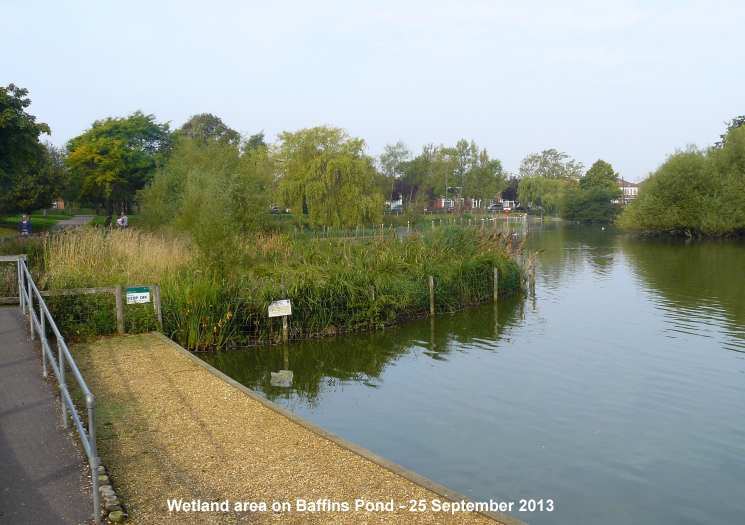
I was even more
pleased to see four Barnacle Geese on the water.
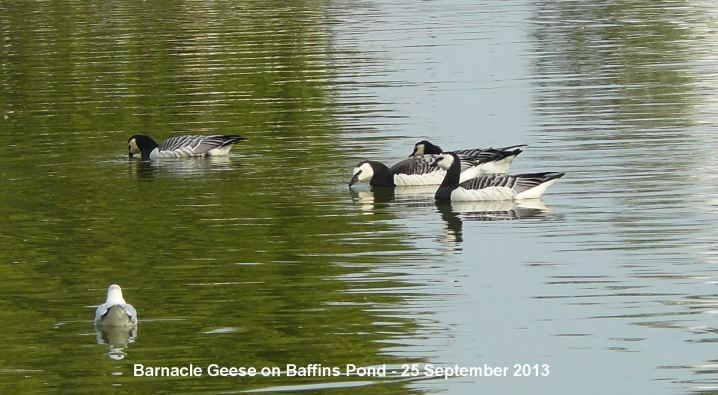
There used to be a
substantial flock of feral Barnacles on the pond
during the 1990s, peaking at a maximum of 42 birds in
1998-99. They were usually accompanied by 2-3 Snow
Geese and were known as the 'Baffins gang' when they
all made regular trips to Titchfield Haven. However,
numbers dropped dramatically until by 2005 there was
no more than a handful left (max of 7). I have not
been keeping track of them since then, but I gather
the pond does get the occasional Barnacle visitors, so
it was good to see some on the pond today.
PETER'S
NEWS
Langstone
Mill Pond
Peter Milinets-Raby
walked along Wade Court Lane to Langstone Mill Pond
(10:30am to mid-day). The best bird of the walk was a
Hobby hunting over the pond for five minutes before it
moved off towards Langstone.
On the pond were: Mute Swan family still with three
very grown up youngsters, 3 eclipse plumaged Shoveler,
6 eclipse plumaged Teal, 1 eclipse plumaged Gadwall,
20+ Meadow Pipits passing over, 3 Chiffchaff, 4
loitering Little Egrets.
Due to the hazy sunshine it was very difficult to see
anything on the low tide mud. Could hear Greenshank,
could see Dunlin, Redshank and Lapwing.
Warblington
shore
Yesterday (24th) Peter
was out birding briefly before high tide along the
Warblington shore (from 12 noon to 1:30pm) and bumped
into Anne de Potier for the very first time. We were
off Conigar Point where we talked at great length
about coloured rings on Greenshank. It was a pleasure
to meet her. Again, because of the glare from the sun
on the mud it was difficult to see stuff properly,
though waders were surprisingly low in numbers.
Brian's note: I think harbour numbers may go up and
down at this time of the year as birds pass through on
migration.
The best sightings
were as follows:
Off Conigar Point (west of Point - little stream
outlet): 7 Greenshank (no coloured rings identified
through the glare), First SHELDUCK of the winter, 80+
Teal, 3 Curlew Sandpipers.
Off Pook Lane: 10 Bar-tailed Godwit, 5 Greenshank, 1
Black-tailed Godwit, 7 Dunlin. ONLY 20+ Redshank
(where did they all go?). It felt like the aftermath
of a bird of prey attack? Nothing around. A constant
stream of Swallows over (200+), 80+ Meadow Pipits
over, 7 Yellow Wagtails in with the cattle.
TUESDAY
SEPTEMBER 24 - 2013
BROOK
MEADOW
Vandalism
Vandals have struck
for the second time on Brook Meadow. A couple of weeks
ago the observation fence in Palmer's Road Copse was
broken down and the rails by the steps to the main
seat had been broken off.
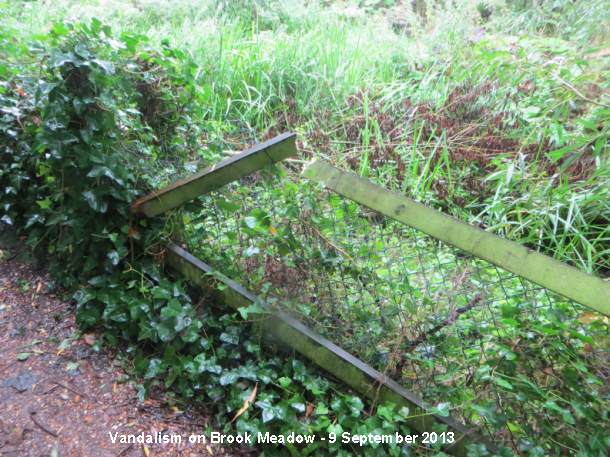
The damage was
promptly made good by Havant Borough Council. A
completely new and very sturdy observation fence was
erected and the rails replaced on the posts behind the
seat.
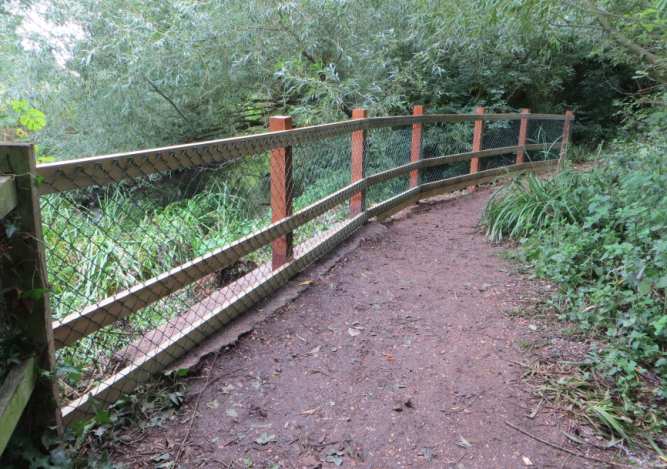
However, yesterday
John Dewars reported that he found the newly repaired
rails had again been torn off the posts. John
retrieved two of the rails from the river where they
had been used as a walkway across the stream. I had a
look this afternoon. The rails had been torn off the
posts with considerable force, leaving bent screws
jutting out from the posts and the concrete base of
one of the posts uprooted. The route taken by the
vandals is clearly visible across the low water river
from the bank beneath the observation fence (which is
undamaged) to the bank by the sluice gate.

Grey
Wagtail
Malcolm Phillips got
this fine image of the new regular Grey Wagtail on the
river on the meadow.
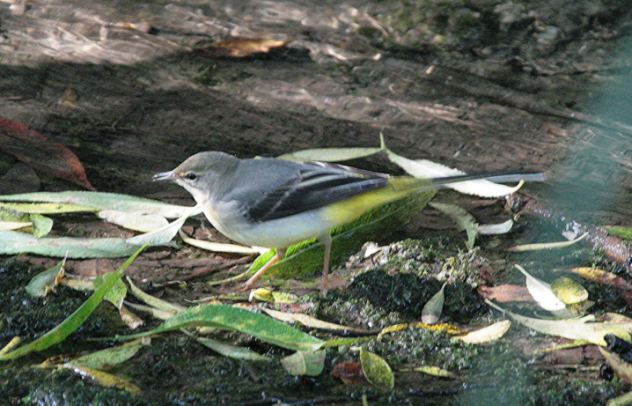
OTHER
NEWS
Hummingbird
Hawkmoth
Roy Ewing sent me the
following photo of a Hummingbird Hawkmoth that visited
his garden in west Emsworth today. Roy's picture shows
the moth typically hovering in front of a flower (in
the manner of a Hummingbird) into which it inserts its
long proboscis to feed on the nectar.
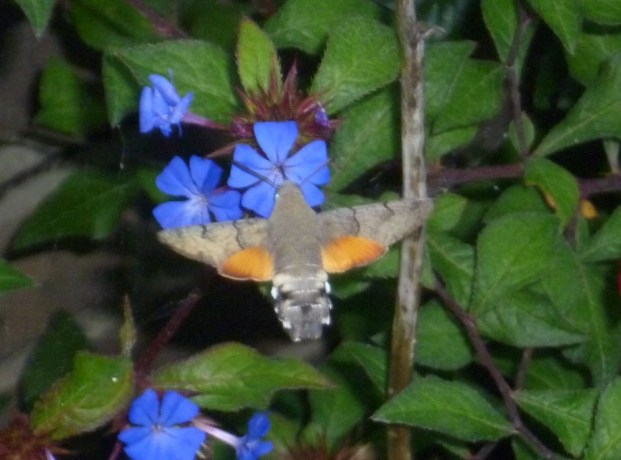
The moth migrates here
from Southern Europe, appearing throughout the British
Isles, in some years arriving in sufficient numbers to
breed. In Hampshire and on the Isle of Wight it
appears annually in varying numbers and was
particularly abundant in 2003. It has been recorded in
winter, and is known to hibernate, and therefore
spring records may refer to overwintering individuals
rather than new immigrants.
Water
Voles in Havant
Yesterday, Nik Knight
visited the Dolphin spring in Havant and found several
strips of bare earth on the roadside bank of the
spring. This made him wonder if a predator had been
digging for the Water Voles, but it was soon clear
that a Water Vole was doing the digging. Ralph Hollins
thinks the voles are 'young explorers' forced to leave
their maternal home somewhere else this summer. Ralph
says, the bank where Nik saw one digging is probably
the only possible site to create burrows around that
pond, but it is very visible to passers by and if
there was a resident population there it seems
unlikely that they would not have been spotted before
now.
MONDAY
SEPTEMBER 23 - 2013
EMSWORTH
HARBOUR
Black-tailed
Godwits
11:00 - 11:30 -
Emsworth Harbour (east) Tide rising. 65 Black-tailed
Godwits including two colour-ringed birds.
O+WL - First sighting this season. Seen 5 times last
winter from 25-Sep to 19-Nov.
G+WR - Second sighting this season. Ringed at
Farlington on 10Sept08 as ad male. Seen regularly each
winter in Emsworth Harbour since then.
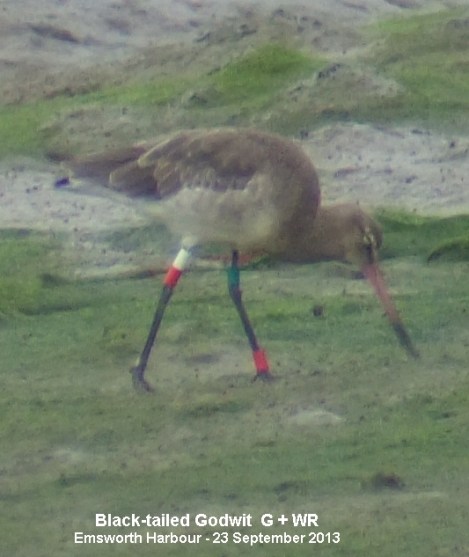
12:00 - 12:30 - On the
western mudflats: 146 Black-tailed Godwits - the
largest count so far this season. I suspect these
included those I previously saw in the eastern harbour
which would by this time be full of water.
Also, 20 Grey Plover,
30 Dunlin. 50+ Teal in the channel at Nore Barn, 23
Mute Swans including the Peter Pond family with one
cygnet.
Godwit
with attached shell
From the millpond
seawall I spotted a Black-tailed Godwit with a shell
of some sort attached to it right foot.
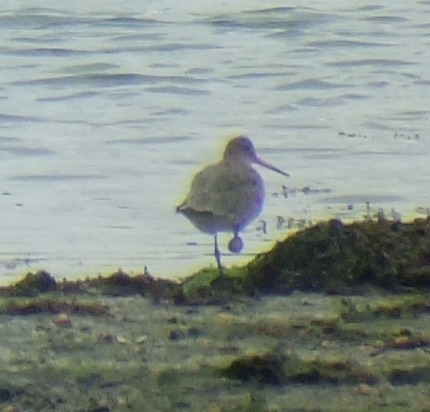
I recall Tony Wootton
photographing a Dunlin with a similar problem on the
Norfolk coast a few years ago. Tony consulted the RSPB
who told him that this was not uncommon in wading
birds feeding on the shore where shellfish were
feeding. They said the shell would eventually come off
when the creature got hungry and released its grip.
Greenshank
In Emsworth Harbour
(east) 5 Greenshank, three of which were
colour-ringed. I have not seen any of these before.
G+YG - LN+RN - (not 100%) - R+NY - (not
100%)
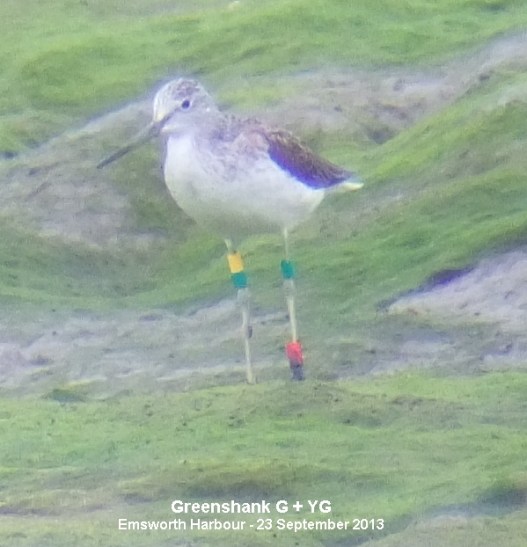
Lesser
Black-backed Gull - ssp
graellsii
On the eastern harbour
was a Lesser Black-backed Gull, which, from its slate
grey back, dark wing tips and speckled head, looked
like a member of the British graellsii
race.
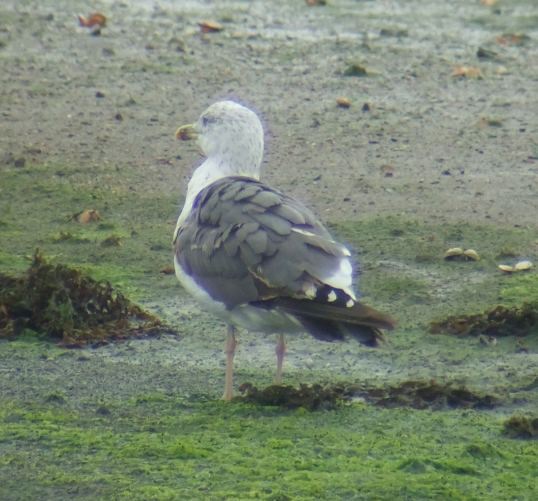
Birds of this race
breed in Britain, Western Europe and Iceland and
winter south to West Africa. They are usually the
first to appear on autumn migration on the south
coast, with Gulls of the darker backed European races
called intermedius showing up later. I often see them
in the local harbours and on the millponds.
SATURDAY
SEPTEMBER 21 - 2013
Warblington
birds
Peter Milinets-Raby
visited the Warblington Shore this morning between
10:15am and mid-day, just ahead of an incoming tide.
The highlights were as follows: 29 Yellow Wagtails
feeding in with the cattle, Swallows seen constantly
moving south east 3 or 5+ every five minutes, giving a
rough total of 100+ in the time Peter spent on
site.
Off Conigar Point: 94
Teal (all in eclipse except two smart looking males),
9 Greenshank ( 7 with coloured rings GR/GO, NG/YY,
LR/NL, GR/YN, NL/YY, RW/BtagY, NR/RO), 11 Bar-tailed
Godwits, 3 Black-tailed Godwits, 12 Dunlin, 22 Grey
Plover. Whitethroat and Chiffchaff in the bushes
here.
Off Wade Court track:
Pre-roost gatherings of 132 Oystercatcher, 33 Curlew,
73 Bar-tailed Godwit, 168 Redshank, 3 Lapwing. A
further 5 Greenshank up to their knees in water so 2
incomplete coloured ringed details. 20 Dunlin.
Langstone Mill Pond:
34 Little Egrets roosting, 2 Grey Herons, 2 Grey
Wagtail, 3 Chiffchaff and female Redstart in nearby
horse paddock.
Swan
attacked
Maggie Gebbett
informed me that a Mute Swan was mauled by a pointer
dog last week and the police were called out. She is
not sure if the swan survived, but it looked badly
injured according to neighbours who saw the incident.
An official gathered it up. This is not the first swan
incident at Nore Barn. I recall seeing a headless swan
corpse here on 24-Nov-11, though I am not sure a dog
was responsible.
Roy Ewing remembers
the headless swan in 2011, but is not sure as to
reason of death. But in Nov 2012 he says they had one
swan killed and two injured by a dog. RSPCA took away
one swan and it survived. This is not the first swan
incident at Nore Barn, I recall seeing a headless swan
corpse here on 24-Nov-11, though I am not sure a dog
was responsible.
Farlington
Marshes
Chris Cope reported on
this morning's walk by the Havant Wildlife Group
Go to . . . http://familyfellows.com/hwg-walk-reports-2013.htm
FRIDAY
SEPTEMBER 20 - 2013
EMSWORTH
Slipper
Millpond
A pair of adult Great
Black-backed Gulls were back on Slipper Millpond this
morning, probably the pair that nested here and
probably the same ones that I saw in the harbour yon
Sep 18. Ominous for next year? Shaggy Soldier is still
in flower on the traffic island on the A259 opposite
Peter Pond.
Emsworth
Harbour
10.30 - Tide rising.
The Greenshank was on edge of the Nore Barn stream
where a pair of Mute Swans were swanning around.
11:00 - The Mute Swan
family with three cygnets, that I saw being chased
from the town millpond by the resident swan pair on
Sep 18 were in the harbour beneath the quay, looking
none the worse for their battering.
Southleigh
Road (west)
I was surprised to
find the verge still uncut; the council usually cut
this one in late summer. The western end of the
wayside is being taken over by young Ash saplings
which are springing up all along this section.
Montbretia was flowering - a new plant for this
wayside. There were a few 'Nursery-web spider' and
shield bugs, but no where near the hundreds I saw here
two autumns ago. The photo shows two Dock Leaf bugs
(Coreus marginatus).
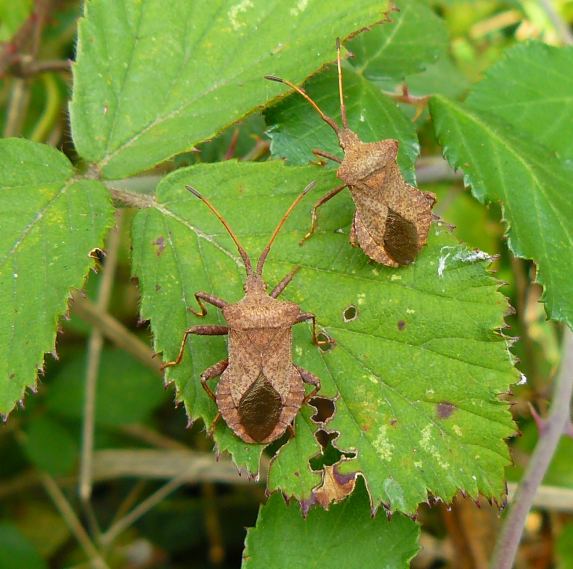
BROOK
MEADOW
Malcolm Phillips had a
good couple of hours round the meadow today. He saw
the Grey Wagtail again under the south bridge and a
Brown Rat. Later he had this rather perky Chiffchaff
near the gasholder. I wonder if this is one that will
be staying with us for the winter?

There was a Moorhen in
the bushes eating the blackberries. At the north
bridge Malcolm again saw an Eel swimming around, but
further on the river was completely dry past the
culvert. Coming back across the meadow he saw a Common
Darter, Red Admiral and Small Copper plus what looks
like a rather aging Dark Bush-cricket with one
leg missing.
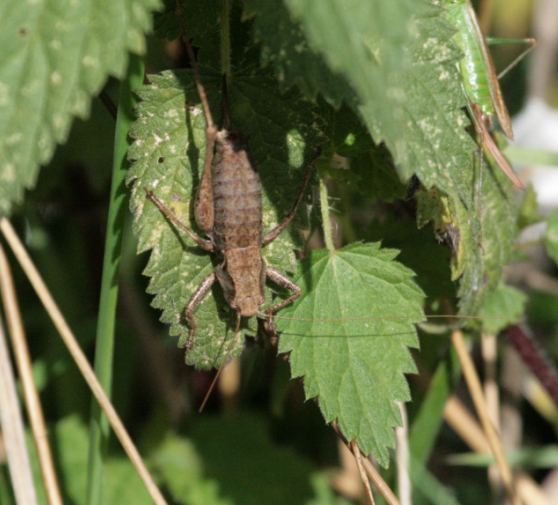
OTHER
NEWS - Osprey
Barry Collins watched
the juvenile Osprey eating a fish on the landing
lights next to nest platform on the east side of
Thorney Deeps on Sep 18. Barry also reported a male
Redstart and four Whinchats on Thorney
Island.
WEDNESDAY
SEPTEMBER 18 - 2013
WAYSIDES
NEWS
I did a quick check
around a few of the local waysides this morning.
Railway
Wayside
I was interested to
walk up the newly cleared track from the railway to
the Washington Road path. I wonder what the purpose of
this clearance is. Maybe to link up with the new
service station, now under construction on the A27? Or
for an access route to the proposed industrial
development to the west of the Washington Road path?
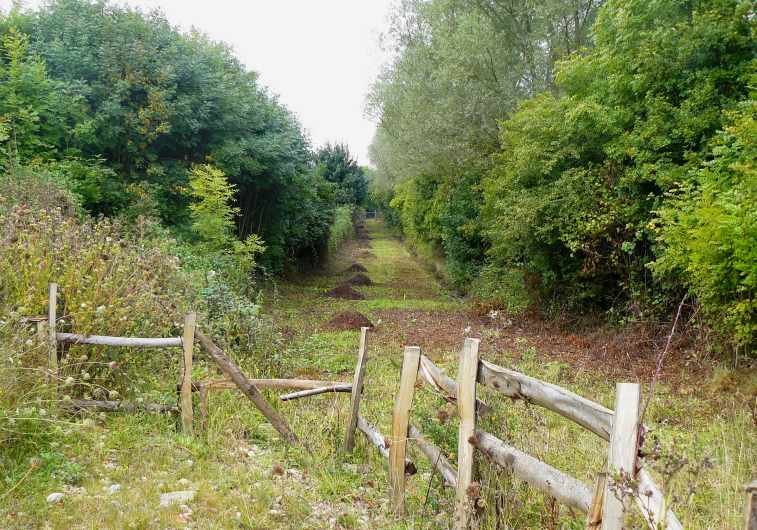
This track now
provides easy access to the small culverted stream
that comes from under the A27 road. The
Narrow-leaved Water-plantain that I found last
year is still there and is in flower. I also found
some Fool's Water-cress, Guernsey Fleabane and Field
Horsetail. These take this year's total for the site
to 137. Although this is an increase over last year's
total of 123, a number of the more interesting plants
that came up last year have not been seen this year,
eg, Marsh Cudweed, Sharp-leaved Fluellen, Small
Toadflax, Small-flowered Crane's-bill and Swine-cress.
Christopher
Way verge
Three plants of Wild
Clary were showing well on the main Christopher Way
wayside, at least one of which had flowers. Here it
is.
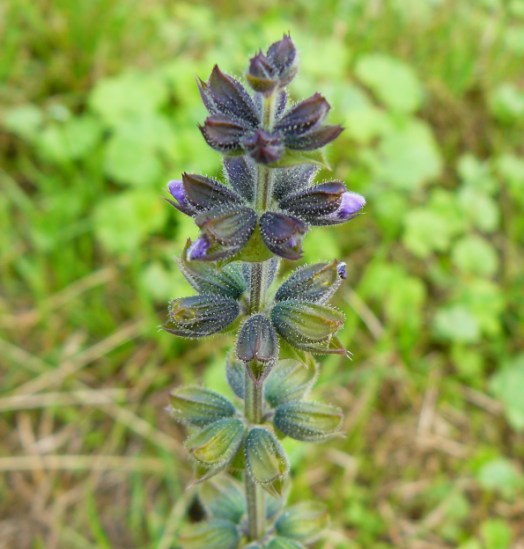
There were another 10
or so Wild Clary plants on the mown Council verge a
little further long the road. This is good news that
we have not lost them all. There is a good crop of
ripe Elderberries on the bush at the western end of
the main verge.
NORE
BARN
Greenshank
I cycled over to Nore
Barn this afternoon, mainly to have a look at the
stream about 3 hours after high water. I knew from
Maggie Gebbett that a Greenshank had been in the
stream and there it was feding happily in the stream.
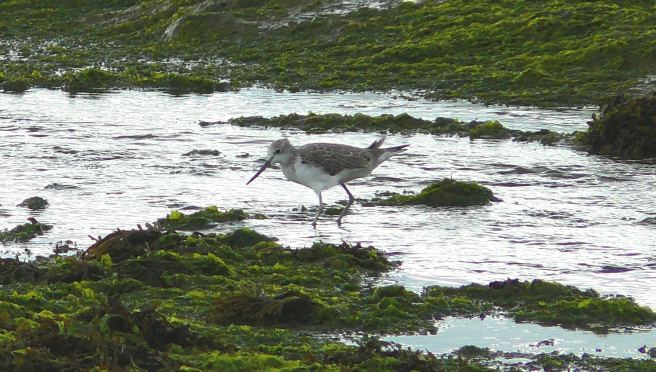
It was an unringed
bird, possibly the same one that usually associates
with the 'tame' Spotted Redshank. On the basis of
previous years, the regular Spotted Redshank, if it
does return for its 10th winter with us, is unlikely
to be here for another 2 weeks. Last year it was back
in the stream on 09-Oct-12 though was the earliest on
record.
Other
observations
A Sandwich Tern
was fishing in Nore Barn Creek south of the woods.
Lax-flowered Sea-lavender was flowering in the
usual place on the small area of saltmarshes to the
east of the stream, but not it seems as much as last
year. I was surprised to see a a single plant of
Chicory in flower on the southern shore of the
woods where the reconstruction has been taking place.
I suspect this plant (or its seeds) came with the soil
brought in to reinforce the bank.
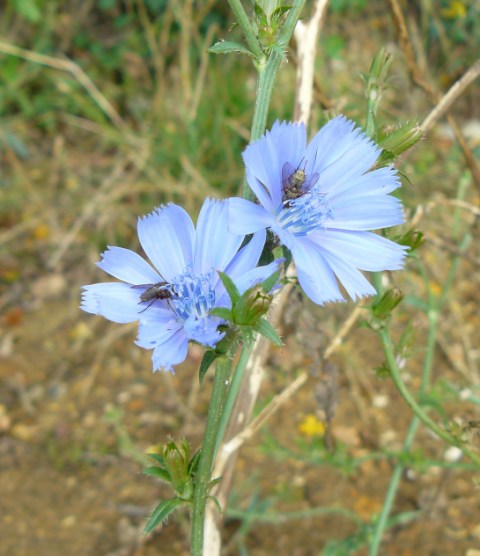
EMSWORTH
HARBOUR
Black-tailed
Godwits
I arrived on the
millpond seawall at about 3pm with the tide falling,
though still fairly well in. A small group of 16
Black-tailed Godwits were feeding on the town shore,
but there were no colour-ringed birds. The group
included three juveniles, which have a pale cinnamon
wash over the neck and breast and neat warm buff
fringes to the brownish upperpart feathers. They stand
out clearly from the adults.
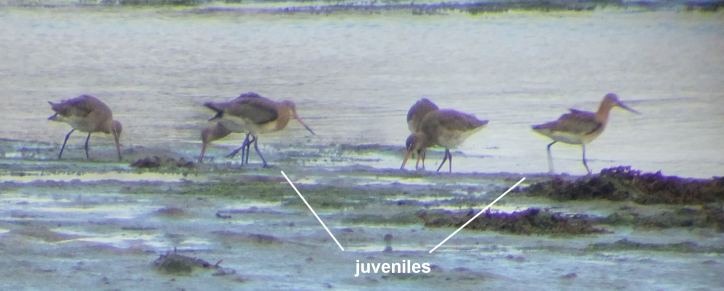
Great
Black-backed Gulls
Two adult Great
Black-backed Gulls were in the harbour along with two
juveniles. These were most likely to be the family
that nested on Slipper Millpond this year. I recall
last year the family also remained in the harbour for
some months after leaving the nest site. Here is one
of the gulls perched on a marker post.

EMSWORTH
MILLPOND
Swan
aggression
I was very surprised
to find the Mute Swan family with three cygnets
(including the white 'Polish' one) on the town
millpond when I arrived there at 3.30pm. This is the
family from the nest on the marina embankment and I
have never seen them on the millpond before, though
they are often in the main harbour outside.
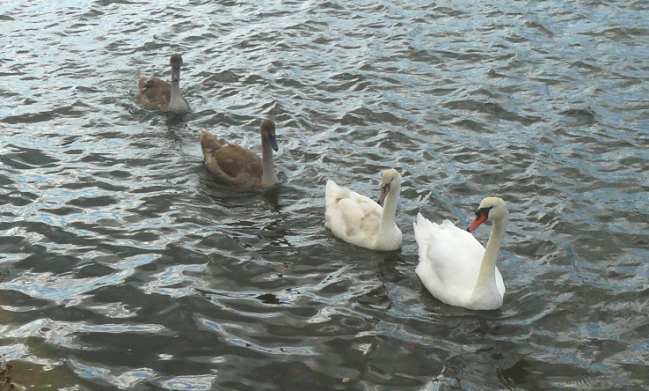
This family was
clearly unwelcome on the millpond and the cob of
resident pair of swans from the 'litter nest',
sometimes accompanied by the pen, relentlessly pursued
the intruding mother swan. However, the marina family
was still on the millpond when I left about 30 minutes
later, though confined to the southern extreme.
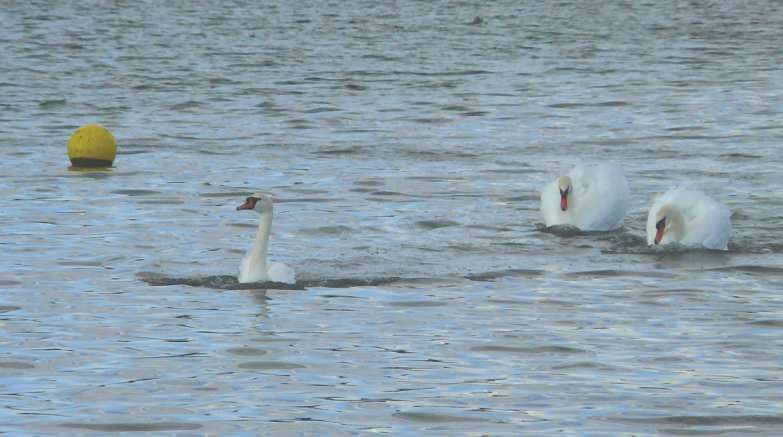
The resident cob also
saw off another group of 4 swans that had strayed onto
the millpond. These observations leaves me in little
doubt that the disappearance of the Mute Swan flock
from the millpond is due to the aggressive territorial
behaviour of the resident Mute Swan pair. However, I
am surprised that the swan's territoriality is still
present.
BROOK
MEADOW
Vandalism
repaired
Malcolm Phillips went
round the meadow today and admired the renewed
observation fence constructed promptly by Havant
Borough Council following vandalism to the old one.
Malcolm noted that the hand rail to the seat had also
been replaced. Well done, chaps for both and thanks.

River
wildlife
Malcolm got this
rather nice photo of a Grey Wagtail showing its
bright yellow rear end on the river near the S-bend,
probably the same bird that I saw near the south
bridge on Monday.
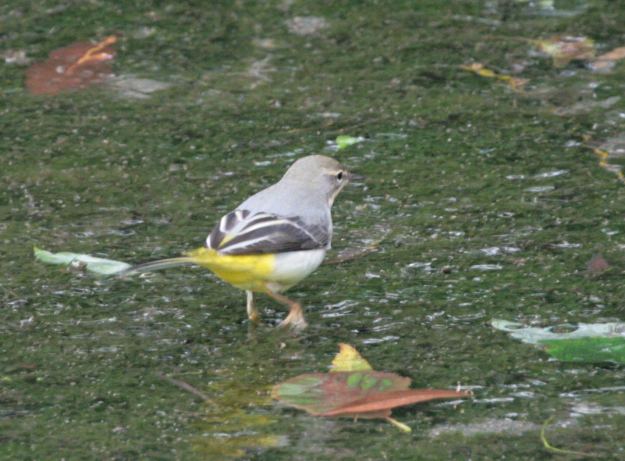
He also spotted
another dead Eel in the river by the south bridge with
a Brown Trout next to it.
MONDAY
SEPTEMBER 16 - 2013
WATER
VOLE SURVEY
Andy Rothwell, a
professional Zoological Surveyor, carried out a Water
Vole survey of the Lumley Stream and the River Ems on
Brook Meadow this morning on behalf of the Brook
Meadow Conservation Group. Today, Andy was assisted by
David Search of the conservation group who had
previously taken part in Water Vole surveys on the
meadow. I accompanied them from the safety of the
river bank, observing and taking photos. Andy
previously did a Water Vole survey for the group in
October 2007, the report of which is on the web site
at . . . http://www.brook-meadow.hampshire.org.uk/bm-water-vole-survey-2007.pdf
They started at Peter
Pond and moved up the Lumley Stream to Constant
Springs. From there they went along the Seagull Lane
path to Brook Meadow to survey the River Ems starting
at the north-east corner at the railway tunnel and
carrying on down river to the south bridge. Here they
are in the Lumley Stream, north of the small
footbridge.

Water
Voles
As would be expected
from the large number of sightings we have had this
year, Water Vole signs were discovered all along the
River Ems, including burrows, latrines, droppings and
food larders. The signs were less frequent on the
Lumley Stream where fewer sightings have been had.
Andy found burrows on
the river bank beneath the railway embankment near the
north-east corner, where we have had a good number of
sightings this year. He thought there could well be up
to three family territories along this stretch of the
river (Section A1) which would spread around the bend
towards the north bridge.
The best cluster of
Water Vole signs were found in and around the dense
patch of Branched Bur-reed on the west bank of the
river opposite the sluice gate. Andy thought this
vegetation could be a general gathering area for the
voles, including those from the Lumley Stream on the
other side of the meadow and should not be removed.
Water Voles love Branched Bur-reed which provides them
with food, cover and protection
For details about the
Water Vole sightings on Brook Meadow for this year go
to . . . http://www.brook-meadow.hampshire.org.uk/bm-water-voles-2013.html
Brown
Rats
Andy and David also
found a good number of Brown Rat droppings,
particularly near the north bend, infront of the
gasholder and in Palmer's Road Copse where rat
sightings have been most frequent. However, Andy
thought the rats were probably not much of a threat to
the voles as they are would have reached a state of
steady co-existence by now. Malcolm Phillips was also
on the meadow this morning and got this photo of a
Brown Rat on the river bank beneath the south bridge.
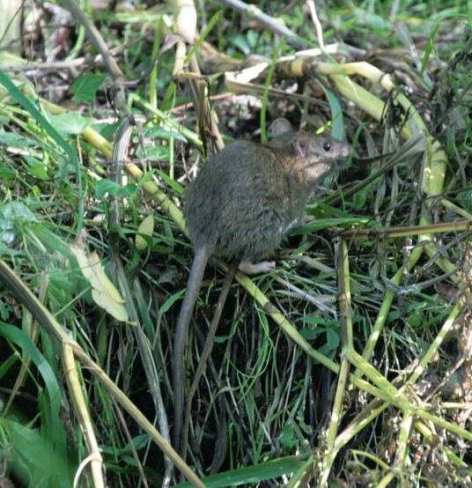
Bank
Voles
Andy also found
evidence of Bank Voles, with droppings being seen on
both the Lumley Stream and the River Ems. There was
one burrow on the east bank just north of the south
bridge which Andy thought, from its small size, was
that of a Bank Vole. I was surprised to hear that Bank
Voles would inhabit wet areas, but Andy said that was
not uncommon and they could also swim quite well. So,
that could possibly account for the sightings of small
swimming creatures that I have previously put down as
possible Water Shrews. Bank Voles and Water Shrews are
about the same size, but look quite different. What we
really need is definite proof in the form of a photo.
Here is a Bank Vole I took from the internet as an
example. It is rather like a miniature Water Vole.
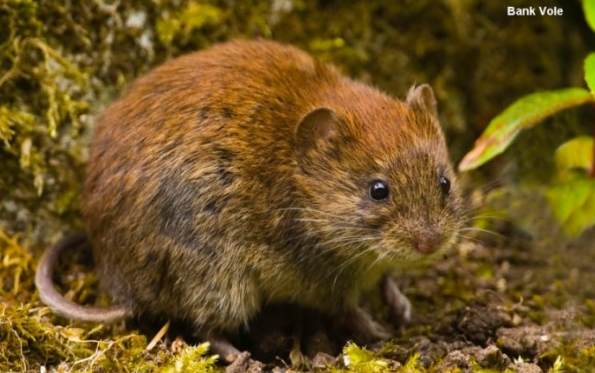
Other
observations
Andy saw two
Kingfishers fly north while he was surveying the
Peter Pond channels. These are probably juveniles
moving towards the coast for the winter.
I saw a Grey
Wagtail beneath the south bridge, but it only
stayed for a few seconds before flying off.
Three medium sized
dragonflies with bright blue bodies were flying around
the main river path near the gasholder. I am fairly
sure they were Migrant Hawkers, though they did
not come to rest. Here is one that Tony Wootton
captured in flight last year.
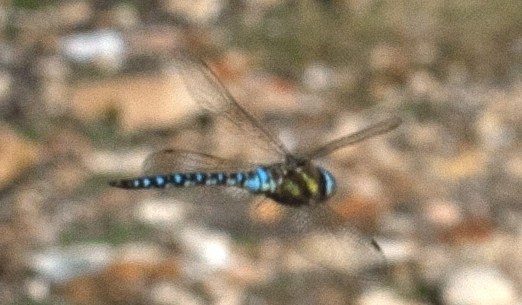
Apart from white
butterflies, there were plenty of Speckled Woods and
just one bright Red Admiral.
Andy discovered an
Eel in the Lumley Stream close to the railway
bridge in front of the house called 'The Arches'. I
have not heard of one in this area before. Andy also
noticed a Bullhead or Miller's Thumb.
Andy showed me some tiny fresh water Mussel
shells that he found on the river bank near the
north-east corner.
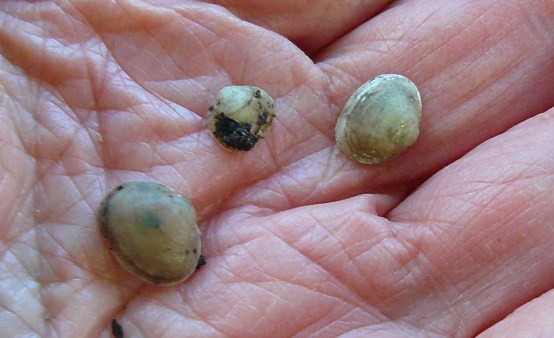
Bindweed leaves on the river bank near the
S-bend have been seriously nibbled by some small
creatures, I know not what.
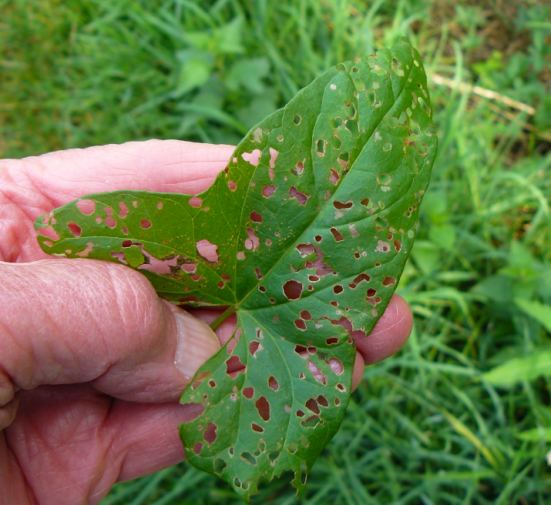
Andy pointed out some healthy Bulrush leaves in
the area north of the observation fence. This was a
relief as I had been a little concerned that we may
have lost them as there have been no flowers this
year. The Bulrush leaves are much taller than the
Branched Bur-reeds and even tower over David Search
who is 6 foot tall. Andy is pointing to them in this
photo.
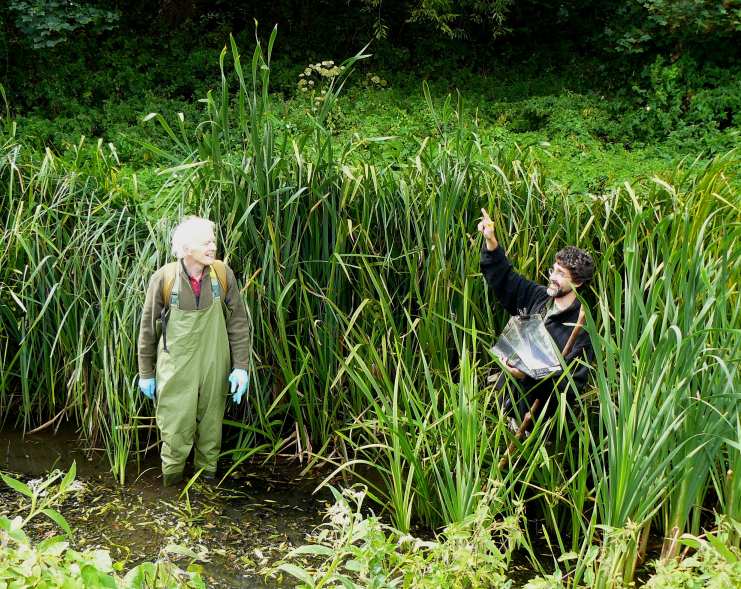
Work is now in progress on the erection of a new
observation fence to replace the one that had been
pushed over last week. We happened to meet William who
is the Council litter man for Brook Meadow. I was
surprised to hear that he had not been off work as the
bins were not emptied for a few weeks recently. I
encouraged him that he was doing a good job for the
meadow environment.
OTHER
NEWS
Roy Hay took this
photo of a Black Swan with the regular Mute Swans at
the top of Fishbourne Creek this morning at high tide.
Black Swans are not uncommon visitors to Fishbourne;
they probably come from the small colony on West
Ashling pond.
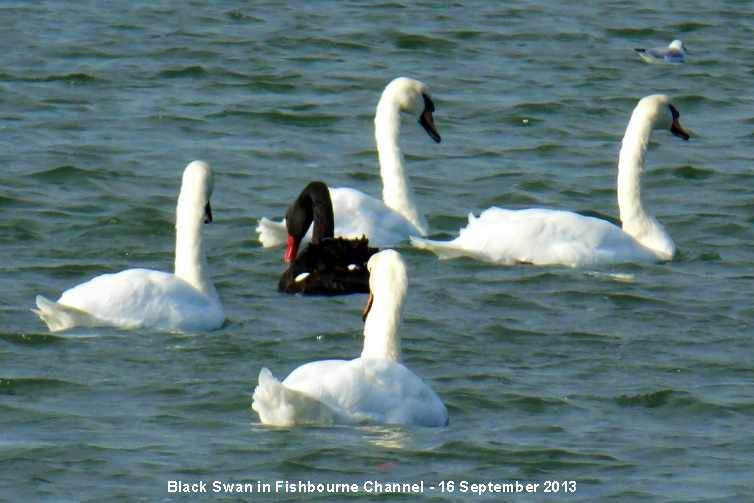
SATURDAY
SEPTEMBER 14 - 2013
North
east Thorney
Tony Wootton reported
on this morning's walk by the Havant Wildlife Group.
Go to . . . http://familyfellows.com/hwg-walk-reports-2013.htm
Mute
Swan news
On Sep 12, Ralph
Hollins found 26 Mute Swans at Nore Barn including a
family of two adults and a single cygnet. He wondered
if they were from the 'litter nest' on the town
millpond, but that family is still on the millpond. My
guess is that it is the family that nested on the
Peter Pond island with one cygnet which have now moved
from the Hermitage millpond complex.
Warblington
birds
Peter Milinets-Raby
popped down to the Warblington shore from 4 pm to 5:30
pm this afternoon to see what was about as the tide
pushed in.
Off Conigar Point: 54
eclipse plumaged Teal, 5 Little Egrets, 6 Greenshank
(4 with rings RW/BtagY and GR/YN and GR/GO and LR/NL),
Single Black-tailed Godwit, 10 Dunlin, Common Tern,
Chiffchaff in the bushes
Off Pook Lane: 54
Dunlin, 6 more Greenshank (2 with coloured rings NR/RO
and RG/YtagY - this bird has a serious limp on the leg
with it's new addition!), 3 Curlew Sandpiper (feeding
with the 100+ Redshank - none with coloured rings?),
54 Bar-tailed Godwits, 2 Black-tailed Godwits, Single
Ringed Plover, 4 Little Egrets, 15+ Grey Plover, 50+
House Martin flying over Langstone Mill Pond (and
another 50+ passing over).
FRIDAY
SEPTEMBER 13 - 2013
WARBLINGTON
Mudflats
and channel
Parking outside
Warblington Church I walked through the cemetery and
through a field occupied by a herd of very peaceful
milking cows, through the kissing gate to the seawall.
This is where Peter Milinets-Raby does his regular
birdwatching sessions and I can appreciate what Peter
likes about the place. The tide was well out by the
time I arrived this morning (10.30) and the birds were
very distant, but I could still make out a good
variety of birds feeding on the mudflats and on the
edge of the main channel.
Three Greenshank
included colour-ringed bird NL+YY which Peter
recorded here two days ago on 11-Sep-13. This could be
one of the newly ringed birds that Pete Potts caught
on Thorney on Sep 8 as I have no previous records for
it. The other Greenshanks were too far away to discern
leg rings. Other birds of interest were 14 Grey
Plover, many of which were still in their summer
plumage 'waistcoats', 8 Little Egrets, 4 Grey Herons,
plus Bar-tailed Godwits, Redshank, Curlew and
Oystercatcher. I did not see any of Peter's Curlew
Sandpipers, though they could well have been out on
the mudflats somewhere.
Church
and cemetery
I had a look around
the churchyard while I was there. I found a good
flowering of Black Nightshade right where I
parked the car in the church car park beside the wall
of the barn.
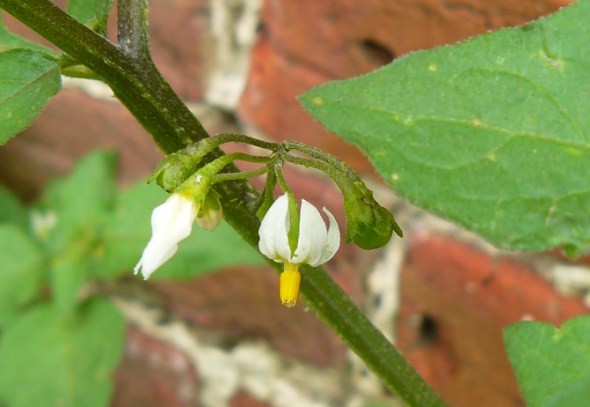
The large Lime
tree in front of the church is covered in clusters
of pale green fruits hanging beneath the strap-like
bracts. These bracts look like leaves, but are much
paler and more lanceolate than the normal heart-shaped
leaves.
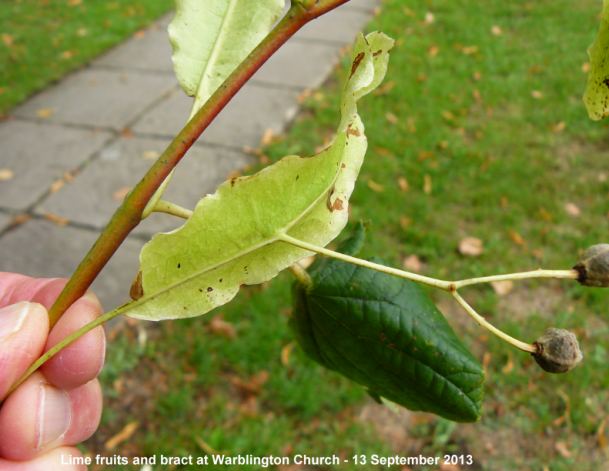
The wild flower
area in the cemetery extension is a jungle of dead
and dying plants, though lots of blue Cornflowers are
still showing brightly. A charm of 20 or so
Goldfinches flew past me in the cemetery extension.
I was watching a
magnificent 4-spot spider (Araneus
quadratus) with a large rounded yellow abdomen
building its web in the wild flower area when a
Cranefly landed in the half completed web. The spider
broke off from its work to subdue the fly and wrap it
up for later consumption maybe.

THURSDAY
SEPTEMBER 12 - 2013
Emsworth
Harbour
10.30 - 11.00 - Low
water. I cycled over to the marina seawall to have a
look at the harbour at low water. I counted 62
Black-tailed Godwits, but there were no colour-ringed
birds. Also on the mudflats were 3 Greenshank, 2
Little Egret, 8 Turnstone, 4 Curlew, 50+ Redshank, 1
Grey Plover (summer plumage), 2 Dunlin - first of the
year and a Lesser Black-backed Gull. The Mute Swan
family with 3 cygnets (including the white 'Polish'
cygnet) from the nest on the marina embankment was
still together in the main channel.

More
Greenshank geolocators
During a catch of 35
Greenshank on 8 September 2013 Pete Potts and his team
fitted geolocators to two retrapped birds, RG+YY and
OO+YY. Both were first ringed by Pete at Thorney on
28th October 2007: RG+YY as an adult and OO+YY as a
juvenile. Note: RG+YY geo was seen by Peter
Milinets-Raby on the Warblington shore on Sep 11. In
addition Pete colour-ringed 33 new birds, 20 of which
were juveniles. Also in the catch were 64 Redshanks, 8
Lapwing and a Dunlin.
See . . . http://www.greenshank.info/the_project/news_detail.asp?latestID=74
Brook
Meadow
Malcolm Phillips went
round the meadow early afternoon and saw Small Copper
and Common Blue butterflies along with a Great Spotted
Woodpecker but no Water Vole today. Here is Malcolm's
photo of the Small Copper. This is a fairly regular
butterfly on Brook Meadow, particularly at this time
of the year when they are having a 3rd brood. It is a
good indicator of ancient grassland and lays eggs on
Common Sorrel and docks.

Sparrowhawk
in garden
Patrick Murphy had a
welcome visitor to his garden this lunch time. A male
Sparrowhawk came for lunch and managed to catch what
Patrick thinks is a Goldfinch. What a cracking photo!
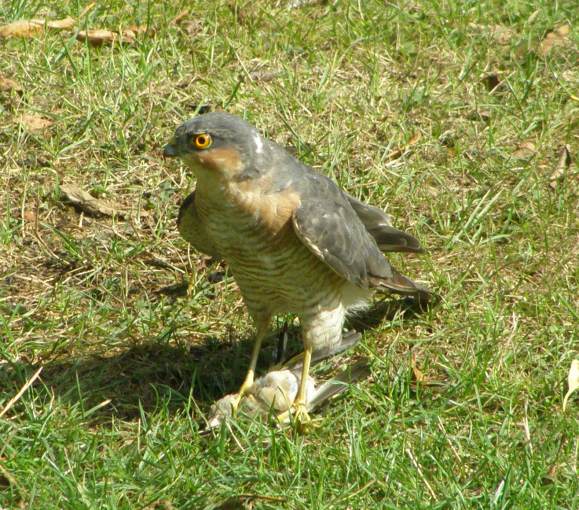
Small
Tortoiseshells rocket!
British Trust for
Ornithology report that the hot, dry weather at the
beginning of July was a turning point for many
butterflies. They highlight in particular the Small
Tortoiseshell which has made a remarkable recovery
this summer after several years of scarcity. Although
their numbers normally increase at the end of the
summer, with new butterflies emerging from the second
brood, the BTO's Garden BirdWatch reporting rate for
the Small Tortoiseshell exceeded expectations for the
time of year, and was double that seen the same time
last year. See . . . http://bto-enews.org/IG4-1RQEL-3RN36S-R323F-0/c.aspx
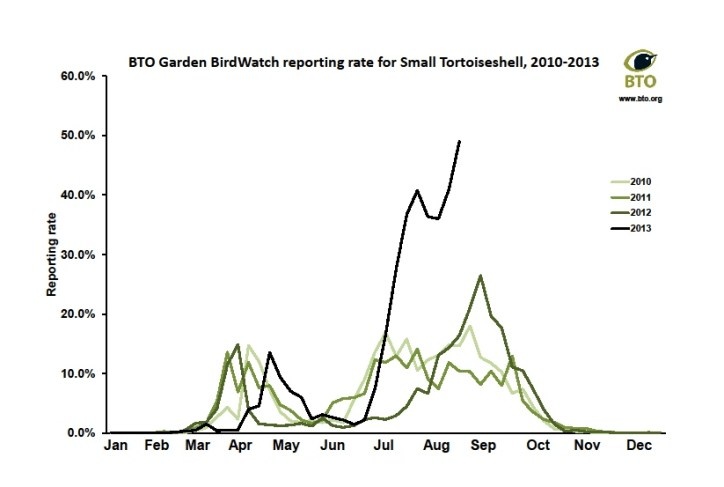
Hayling
Oysterbeds - latest news
Chris Cockburn
provides the latest news from the
oysterbeds
The breeding season is
still not officially over! There are still two
non-flying Common Tern youngsters and it is hoped
(fingers crossed) that these two will successfully
fledge very soon because they are the only brood of
two (all other fledged common terns were singletons).
So, despite the late and protracted starts at the
Oysterbeds and with the adults not in prime condition,
the productivity for these terns is reasonably good
(at least 56 - possibly 58! - fledged youngsters from
73 pairs). Hopefully, next year there will not be such
a protracted nesting period for the common terns - it
has been a bit of a nightmare keeping track of the
numbers of pairs and fledged birds!
Like for the
Mediterranean & Black-Headed Gulls, predation of
eggs or chicks has not been a serious issue for the
common terns this year. There does seem to have been
some problems with food supply (at times; Pipefish and
'flatfish' were frequently seen being fed to chicks
and there were many periods with winds of F5 or above,
making it difficult for adults to hunt for fish prey).
Also, few nests were flooded during the big spring
tides on 22 & 23 August.
In summary, an
excellent breeding season at the Oysterbeds
(Mediterranean gulls had a productivity rate of 1
fledged young per pair while the Black-Headed Gull
rate was at least 1.65).
The third year of
enthusiastic RSPB Volunteer Guides being regularly on
site and armed with telescopes (to enable any passing
person to see the birds close-up) has proved to be a
great success. Good relationships have been struck up
with a wide range of people from daily dog-walkers to
once-a-year holiday-makers and, especially
encouraging, Island residents on their first-ever
visits - many of these folk then acquire a keen &
sympathetic interest and enthusiasm for what happens
at the site (with human nature as an excuse, it seems
that we remember more dogs' names than their owners'
names!). It would be great if even more people could
offer a few hours of their valuable spare time to
become Volunteer Guides.
As soon as the last
common terns have left the site, it is hoped that
volunteer work parties will clear the vegetation from
the two islands in the lagoon and thereby encourage
even more waders to roost there over high tide
periods. Despite the present copious amounts of
vegetation (mostly annual plants such as Spear-leaved
Orache and Chamomile species) the islands have
recently held high spring tide roosts of
oystercatchers, ringed plovers, dunlins, turnstones,
redshanks, greenshank (OK, only 1 or 2!), common
sandpiper and even the occasional superb
summer-plumaged grey plover. Prior to high tide, Stoke
Bay has been busy with many little egrets and waders,
particularly good numbers of ringed plovers.. Apart
from (close by) kestrel and (distant) views of
foraging & roosting ospreys, raptor activity has
been very low so far. However, it has been good to see
a larger-than-in-recent-years flock of starlings often
feeding on the inter-tidal areas.
The first of the
returning brent geese (failed/non breeders) should be
in the harbour soon - hopefully, there will be very
few in September but a massive arrival of family
groups in mid-Oct.
WEDNESDAY
SEPTEMBER 11 - 2013
Brook
Meadow
Malcolm Phillips saw
the Water Vole again at the north bridge about 10.20am
this morning. And the vole saw him!
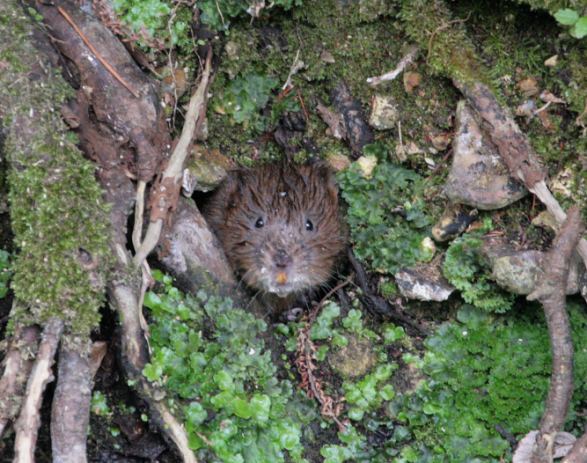
Malcolm also saw Brown
Trout and an Eel in the river near the bridge, the
latter for the first time that far up
stream.
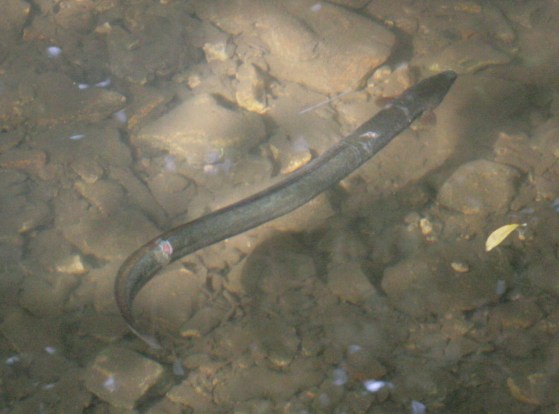
Warblington
birds
Peter Milinets-Raby
walked the Warblington shore at lowish tide from 11 am
to 12 noon. He found 2 Curlew Sandpipers in one of the
muddy gullies away from the Dunlin. Also on the
exposed mud were: 71 Dunlin, 12+ Grey Plover (too
spaced out to count properly at this point in the
tidal state), 7 Greenshank (3 with coloured rings
NR/RO and NL/YY and RG/YtagY - Peter has not
noticed the tag on this one before or something has
become attached to the ring - it did not seem happy,
limping!). 14 Bar-tailed Godwit (3 in summer plumage),
Yellow Wagtail 4 over, 4 Meadow Pipits over, Common
Tern 2, Ringed Plover 2, up to 50 Swallows over all
heading north. Plus one Sand Martin. Note on
Greenshank RG+YtagY - Pete Potts says RG+YY was one of
two Greenshank retrapped and fitted with a tag at
Thorney last weekend.
Colin's
pics
Colin Vanner has not
been out lately but he got the chance to nip out when
working over Arundel and got two super shots which he
would like to share with us. Brilliant.
A
Hobby being chased by what looks like a Rook
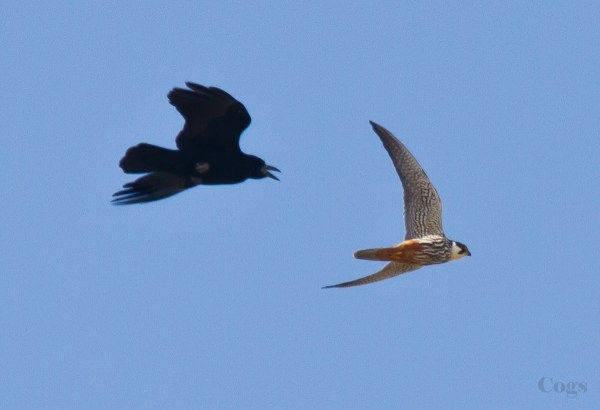
A
couple of Red Kites playing above the fields. Colin
says there were about 6 Kites in the sky at one time.

TUESDAY
SEPTEMBER 10 - 2013
BROOK
MEADOW
Malcolm Phillips had
another Water Vole on Brook Meadow this morning, just
up from the north bridge. Here is Malcolm's delightful
photo with the vole looking up and almost saying,
"Hallo, nice to see you again".
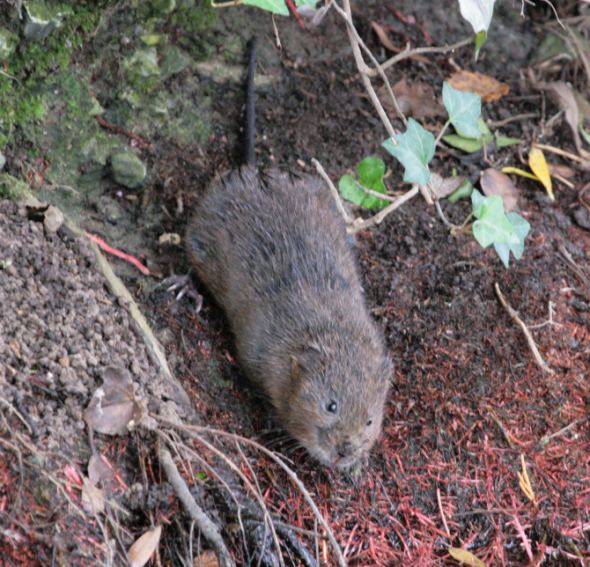
MONDAY
SEPTEMBER 9 - 2013
Osprey
on Thorney
Tony Wootton spent a
couple of hours this morning looking for the Osprey on
the east side of Thorney Island. First, he parked down
at the far end of Thornham Lane, where 'a very
pleasant and polite lady' informed him that the area
was now "residents only" parking. He got down to the
eastern army gate when the rain came, but there was
the Osprey, sitting on a post about as far away as
possible along the southern bank. Tony then went round
to Thorney Road and along to the gate opposite the
entrance to Eames Farm where he had another view of
the Osprey. After about 20 mins it flew off, not to
return, but at least it gave Tony a photo opportunity.
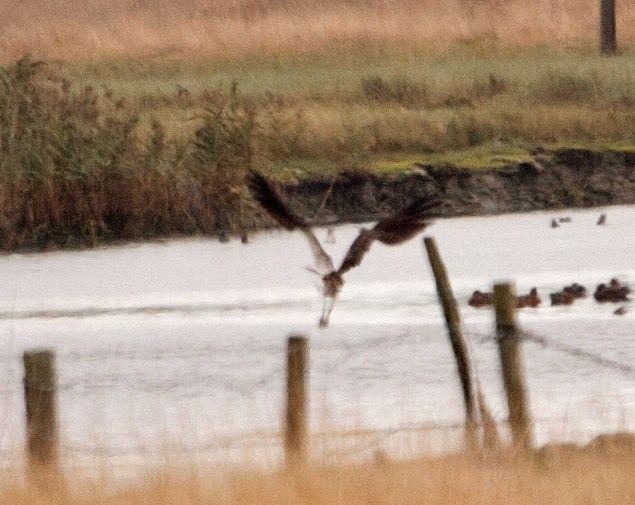
Having read Tony's
report, and not having seen the Thorney Osprey myself
this year, I decided to cycle down to the end of
Thornham Lane this afternoon to have a look. It was
still there, perched on one of the old landing lights,
and did not move during the 15 minutes or so that I
was there. But it was good to see, nevertheless. Who
is the mystery walker with scope behind the Osprey, I
wonder? It must be official conservancy staff as this
area has no public access.
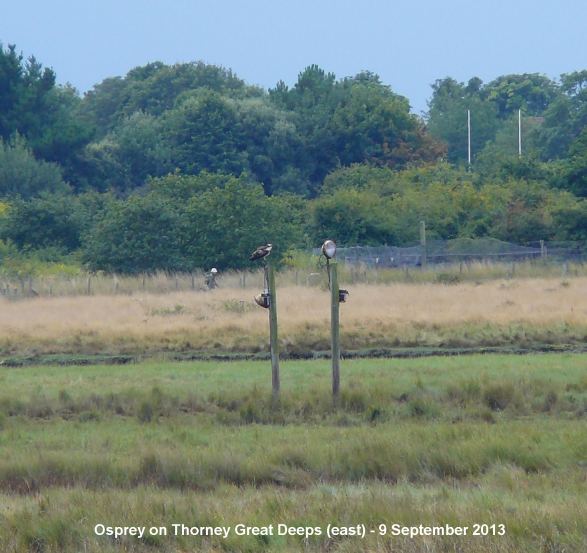
'Infestation
of Caterpillars'
Terry Lifton who lives
in Westbourne Avenue has had what she called 'an
infestation of caterpillars' in her garden. She sent
me a photo of a couple of them.
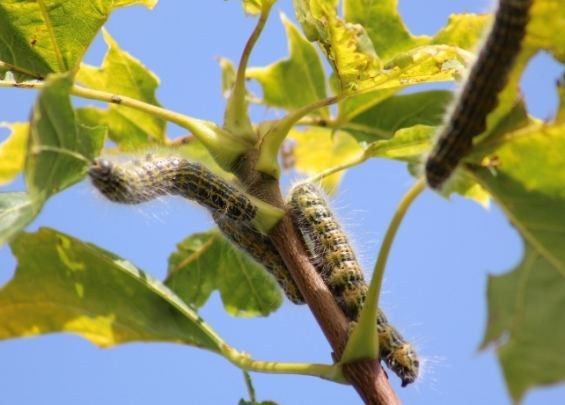
I agree with Terry's
identification as the larvae of the Buff-tip Moth. The
caterpillars are seen from July until October and
overwinter as a pupa. My book says they feed on many
deciduous trees and are gregarious when young, which
seems to fit with Terry's observation. The adult moth
looks like a twig from a tree and is seen from May to
July, if you can spot it, that is.
Vandalism
on Brook Meadow
Malcolm Phillips was
dismayed to discover some serious acts of vandalism on
Brook Meadow this morning. The observation fence in
Palmer's Road Copse had been pushed over, the rails up
the steps to the main seat had been broken off and the
fence by the water vole notice had been pushed over.
This is the first serious vandalism we have
experienced on Brook Meadow for several years. Here is
Malcolm's photo of the observation fence down.

Water
Vole
Malcolm saw a Water
Vole on the north bank near the railway embankment but
was unable to get a photo as it was too quick for him.
This was our first Water Vole sighting anywhere on the
river, except for the south bridge area (Section D),
for 6 weeks.
SUNDAY
SEPTEMBER 8 - 2013
Emsworth
Harbour
I checked the eastern
harbour this morning at 10.30 on a rising tide. I
counted 76 Black-tailed Godwits, but not a single
colour-ringed bird. Other birds in the harbour
included 2 Greenshank, 2 Little Egret, plus a few
Redshank, Oystercatcher, Turnstone and Curlew.
Thorney
Deeps
I carried on down the
west side of Thorney as far as Great Deeps looking for
the missing Mute Swans from Emsworth Millpond, but
there was no sign of any. The regular Mute Swan pair
was on the Little Deeps with no cygnets. Sea Asters
were in flower alongside the track down to Great
Deeps.
Privet
Hawkmoth
Dave and Paula
McVittie who live in Pagham Close Emsworth sent me
this photo of what they referred to as "an enormous
caterpillar that is in the process of eating or bush
in our front garden".

This is a fine Privet
Hawkmoth caterpillar which feeds on a variety of
plants apart from Pivet, including Lilac, Ash,
Elderberry, Guelder-rose and Snowberry. It usually
feeds in an upside position, as it is in Dave and
Paula's photo. The larva changes to a dull brown
before it burrows into the ground to form a chrysalis
nearly 6 ins deep in the soil - the deepest of any
moth larvae. It may remain dormant for up to two years
before hatching out into a handsome moth. The Privet
Hawkmoth is confined to southern England and may be
seen in June and July, though the caterpillar is more
often seen than the adult moth.
SATURDAY
SEPTEMBER 7 - 2013
EMSWORTH
A Great
Black-backed Gull was standing on the north raft
on Slipper Millpond when I passed by this morning. It
was probably the female of the pair (with a softer
face) that nested here this season on a nostalgic
visit. Or prospecting for next year, maybe? There was
no sign of the Mute Swan family from the Peter Pond
nest; they must have moved off into the harbour.
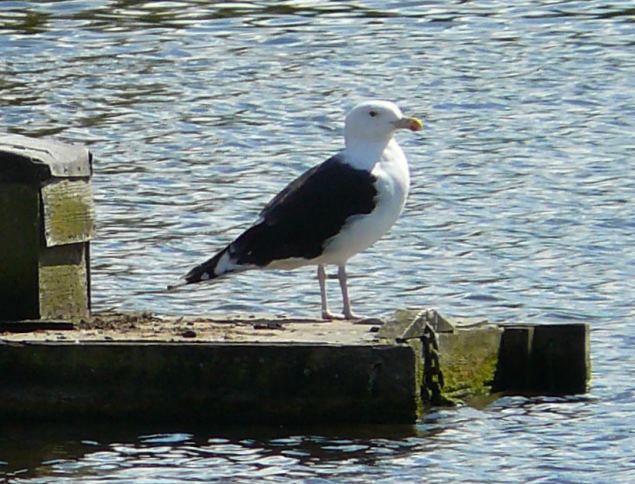
Malcolm Phillips was
on the meadow today and got photos of Clouded
Yellow - good to know they are still on the
meadow. He also got yet another male Common Darter -
they really are common at this time of the year.

Maggie Gebbett went
swimming in the sea at Nore Barn today in company with
26 Mute Swans, probably deserters from the town
millpond. I gather there are also good numbers of
swans on Thorney Deeps, which probably accounts for
the rest. As they get back their powers of flight
after the annual moult, I would not be surprised to
see them coming back to the millpond fairly soon.
STAUNTON
COUNTRY PARK
Heather Mills reported
on this morning's walk by the Havant Wildlife
Group:
See . . . http://familyfellows.com/hwg-walk-reports-2013.htm
FRIDAY
SEPTEMBER 6 - 2013
Water
Voles in Havant
Dave Bull was pleased
to see two Water Voles playing in the watercress pond
Tesco Superstore. In fact, there has been a flurry of
Water Vole sightings in this stream that runs beside
the Tesco store in Havant, on the west side of Park
Road South. Ralph Hollins is sure there are at least
two Water Voles currently present in the area, but
thinks they are not resident but are wanderers from
some as yet unknown birthplace (most likely on the
banks of the Langbrook Stream), but would welcome any
further information about breeding places or about the
highways that bring these animals to Havant, seemingly
each summer. See his diary for Sep 2 for full details
. . . http://ralph-hollins.net/Diary.htm
Little
Egrets at Langstone
Last night Ralph
Hollins counted 107 Little Egrets entering the roost
in the trees behind Langstone Mill Pond which he
thinks will be the highest count for the year. See his
diary for full details . . . http://ralph-hollins.net/Diary.htm
I have not heard any news recently about the Little
Egret roost on Thorney Island.
Ospreys
locally
Ospreys are moving
through our area on their way to their wintering
grounds in Africa. One regular stopping off place is
the deeps on the east side of Thorney Island. The most
recent sighting was by Barry Collins who saw two
Ospreys fishing off Pilsey Sands at the southern end
of Thorney Island at 10.20 yesterday morning (Sep 5).
The other popular
stopping off place for Ospreys is Farlington Marshes
where two have been seen over the past weeks or so,
usually on the RSPB islands. Bob Chapman has a photo
of one of them on North Binness Island on his blog for
Sep 4 . . . http://solentreserves.wordpress.com/
THURSDAY
SEPTEMBER 5 - 2013
BROOK
MEADOW
Oak
Leaf Galls
The young Oaks on the
Seagull Lane patch have lots of galls on their leaves.
The most common ones are the brown Common Spangle
Galls that lie flat on the under surface of the
leaf.

They are caused by a
gall wasp called Neuroterus
quercusbaccarum
which lays eggs on the leaves and the grubs induce the
formation of the galls. The life history is quite
complex. The spangle galls fall to the ground and
parthenogentic females emerge early in spring to lay
eggs in Oak buds. A new generation of grubs then
induces the formation of currant galls on young leaves
and catkins. Male and female gall wasps emerge from
these galls and, after mating, the whole process is
repeated with eggs being laid on leaves leading to
more spangle galls.
I also noticed a few
very tiny spherical galls on the leaves which I think
might be those of the gall wasp called
Cynips
divisa.
Here are two of these galls with red markings,
attached as you can see to a vein on the leaf, as they
all were.
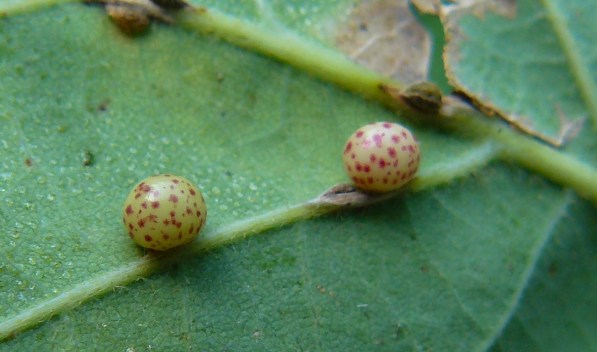
My copy of Chinery
(p.229) has an illustration showing these galls which
closely matches those I found on the Brook Meadow
leaves. The galls are attached by a short stalk and I
easily dislodged one on a leaf I brought home with me.
It literally rolled around on the leaf, as if it were
alive - which, of course, it is!
Common
Darters
From the south bridge
I watched a pair of Common Darters flying around in
tandem with another male in close attendance. This was
the best shot I could get of the lone darter, the pair
was quite impossible.
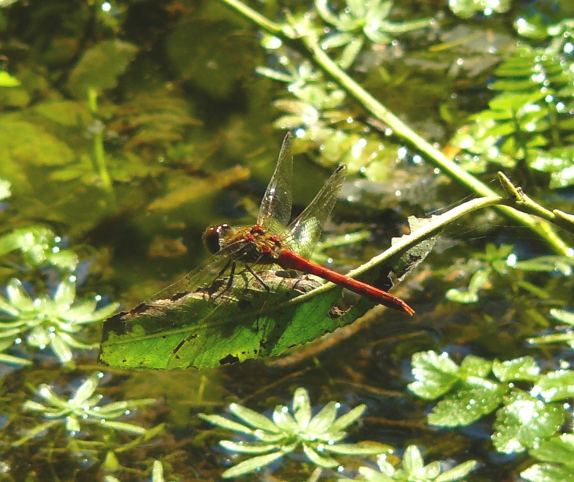
WARBLINGTON
BIRDS
Peter Milinets-Raby
had another good sesion on the Warblington shore this
morning from 9am to 10am about 2-3 hours to high
water. On arrival the waders were were spread out, but
after only five minutes a Peregrine flew through the
horde and caught a Dunlin, then flew off inland with
its catch. The waders obviously scattered and then
congregated together on the mud adjacent to Pook Lane.
A spectacular sight.
184+ Redshank, Winter
plumaged Spotted Redshank, 45+ Dunlin, 4 Black-tailed
Godwit, 2 Ringed Plover, 28 Grey Plover (though these
however, did not move from their pre-roost gathering
spot off the church?), 8 Greenshank (two coloured
ringed NR/RO and RG/YY - the usual two of late), 11
Curlew Sandpiper (all juveniles).
Other species of note
included: Sandwich Tern (full summer) and Common Tern
feeding a juvenile. 6 Yellow Wagtails (3 over and 3 (2
juvs, 1 adult) in amongst the cattle that were grazing
in the field next to the cemetery).
WEDNESDAY
SEPTEMBER 4 - 2013
Common
Darter
Malcolm Phillips got
this excellent image of a Common Darter dragonfly on
Brook Meadow today. The photo closely matches the
illustration of what Brooks and Lewington refer to as
an 'over mature female' in their dragonflies and
damselflies guide. The normally mature female's body
is yellowish. The male has a bright red abdomen.
Common Darters are fairly common dragonflies on Brook
Meadow in late summer, often seen perching near the
south bridge or on grasses by the waterways, as in
Malcolm's photo.

TUESDAY
SEPTEMBER 3 - 2013
Elephant
Hawkmoth
Frank Naylor had a
beautiful Elephant Hawkmoth caterpillar in his garden
today. They are certainly dramatic creatures and I
have known them to be mistaken for small snakes.
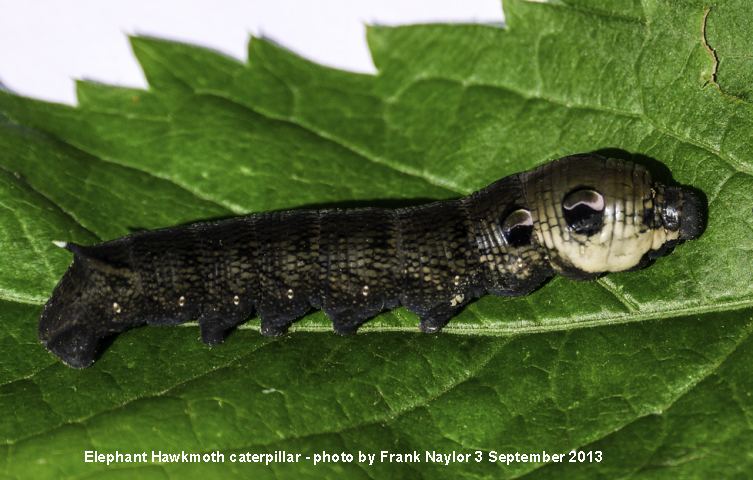
The trunk-like snout
at the head end of the larva gives the creature its
name. It can be extended or retracted as a defensive
tactic; when threatened the caterpillar draws this
trunk in towards its body which shields the head from
danger and inflates the body, making the four eye
markings look much larger and more threatening to any
predator. They are common in gardens where they gorge
themselves on fuchsia stems and leaves. When fully
grown the caterpillar moves down to the ground to
pupate and remains in this state until the following
spring (around May) when it emerges as an adult moth.
Warblington
birds
Peter Milinets-Raby
had an excellent morning down along the shore south of
Warblington Church (6:20am to 9am). Very few grounded
migrants, but for 2 Chiffchaff and a female Blackcap
in the bushes at the end of the new cemetery
extension. The flock of Goldfinch had reduced to 15+.
He had a total of 15+ Yellow Wagtails fly over this
morning.
Peter's best birds of
the day were 10 Curlew Sandpiper feeding in the
muddy gullies on the incoming tide. They were a bit
mobile and difficult to count, but he thought there
could have been up to 13. They were feeding on their
own for most of the time, only occasionally
associating with a few Dunlin. As the tide came in
they headed off to Langstone Harbour. These will have
been passage birds, probably juveniles, on their way
from their breeding grounds in Siberia to their
wintering grounds in tropical Africa.
An Osprey flew west
along the channel at 7:42am, flushing all the waders
and gulls. It headed over the Hayling Bridge and out
into Langstone Harbour. As the tide pushed in the
following numbers were noted; 5 Greenshank (two
coloured ringed birds NR/RO and RG/YY), 39 Dunlin, 28
Grey Plover, 2 Black-tailed Godwit (with a flock of 12
heading to Conigar Point and beyond). 6 Ringed Plover,
A winter plumaged Spotted Redshank amongst the 100+
Redshank, 4 Little Egrets. 3 winter plumaged Sandwich
Terns.
SUNDAY
SEPTEMBER 1 - 2013
BROOK
MEADOW
Conservation
work session.
I went over to the
meadow on a perfect autumn morning for the regular
conservation work session attended by 14 volunteers,
including two newcomers. I was the 'official'
photographer as usual. The main tasks were clearing
the casual paths in the south meadow, clearing around
the hedgerow on the Seagull Lane patch and general
litter picking. For more photos go to the Brook Meadow
web page at . . . http://www.brook-meadow.hampshire.org.uk/bm-diary-work-2013.html
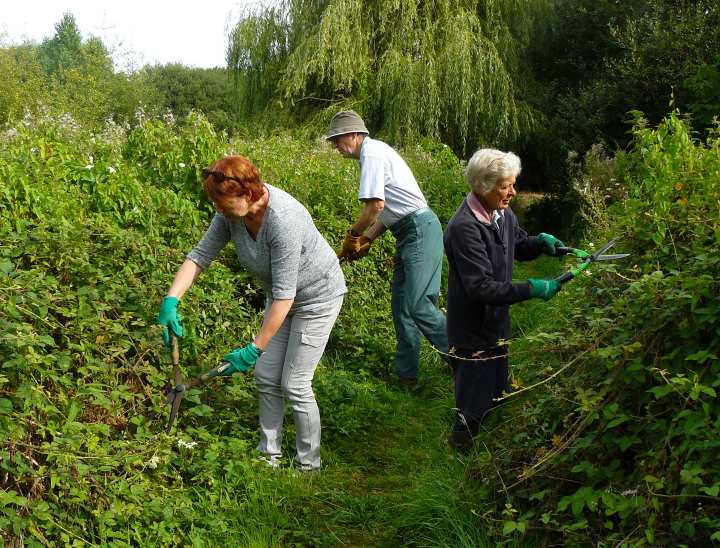
Dead
Sparrowhawk
During their clearance
work in the south meadow the volunteers discovered a
very dead Sparrowhawk. There was no obvious signs of
any damage though it was full of maggots. There was no
ring. I know Sparrowhawks do occasionally stun
themselves by smashing into patio windows, so it is
possible that this bird broke its neck when it
inadvertantly crashed into a tree while pursuing some
prey.
Dead
Sparrowhawk from above
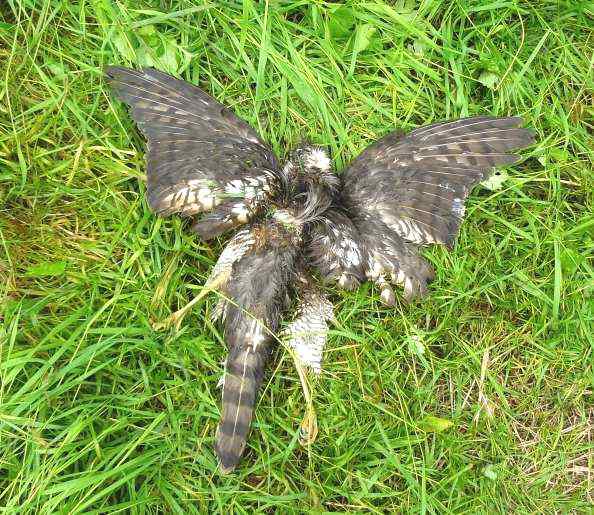
Birds of Britain web
site states . . . " In full pursuit the Sparrowhawk
can be extremely persistent, often getting into
difficulties. It will blindly chase after its
terrified quarry into a room, crash to death against a
window, strike wires or become fatally wounded after
crashing into a thick hedge or bush". http://www.birdsofbritain.co.uk/bird-guide/sparrowhawk.asp
I bagged the
Sparrowhawk up and brought it home to measure it. Wing
span of 60cm and length of 40cm are in the range of a
female bird; a male would be much smaller. The pale
edges of the wing feathers and rather broken barring
on the underparts suggests a juvenile.
Dead
Sparrowhawk underparts
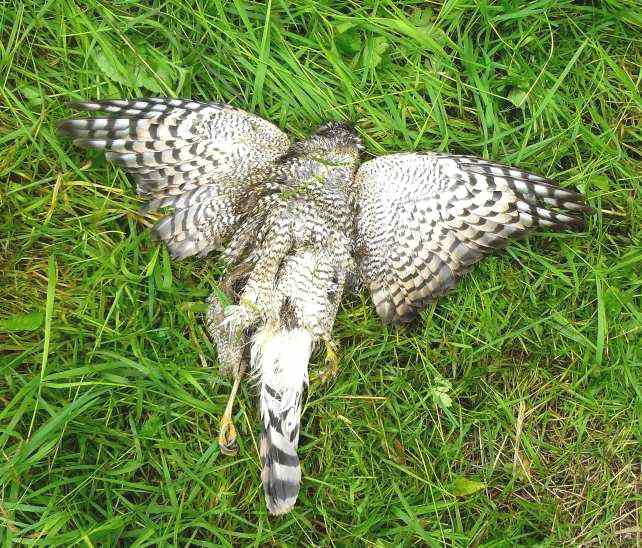
Other
observations
Two Robins were
singing their autumn song on the Seagull Lane patch.
Lots of white
butterflies have been feeding on the flowers over the
past week. Here is a rather nice female Small
White showing its yellowish underwings, and dark
marks on the upper wings with indistinctly marked
tips.
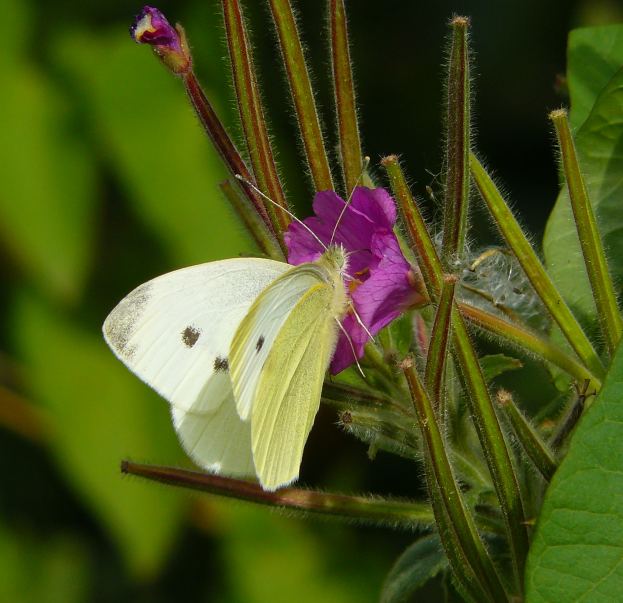
Purple Loosestrife is
flowering very well on the river bank south of the
north bridge.
The Red Oak tree which
was planted on the Seagull Lane patch in memory of
Tony Wilkinson last year is not looking very healthy
and has not had any new growth. The conservation group
are giving it regular water, but the problem seems
more serious. In contrast, the planted Pedunculate
Oaks are doing fine.
Wally told me that
Martin Cull will be returning in late September to do
more cutting of the meadow, including the wet Lumley
area and the centre meadow. The main orchid area on
the north meadow will be cut by the group using the
power scythe.
OTHER
NEWS
Sadler's
Walk pond
The Moorhens appear to
be thriving on this semi-natural pond at the top of
Sadler's Walk in the new housing estate east of Lumley
Road. There are now three generations of Moorhens on
the pond with youngsters from the first brood helping
to look after and feed small chicks from a second
brood. The weed in the pond is so thick that the
Moorhens can walk on the surface of the water. I am
not sure of the weed, but I did notice some Marestail
growing in the pond.
Juvenile
Moorhen feeding a chick

Frogs
Jill Stanley was
gardening this afternoon and planning to plant a shrub
that had been in a pot for several weeks just sunk
into a hole in the ground. When she lifted the pot out
she found two Common Frogs sitting in the hole. She
rushed for her camera and got this cracking shot of
one of them.
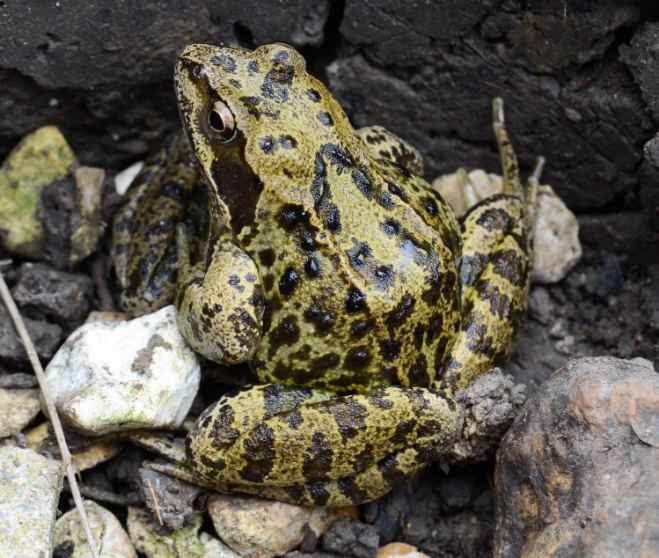
Godwit
news from Iceland
Pete Potts said the
Black-tailed Godwits had a mixed breeding season in
Iceland. Cold winds in April/May delayed arrival and
then cold weather with lingering snow esp. in the
north of Iceland with snow still laying thickly in
late May. The godwits in the south of Iceland seem to
have done badly but in the north they have done well.
Pete was there and marked c.75 godwit chicks and 5
adults.
He is planning to try
and catch greenshanks and godwits on Thorney in coming
weeks.. so wish them luck as they hope to retrap the 3
geolocator birds which are all now back at
Thorney.
Warblington
news
Peter Milinets-Raby
walked from the Wade Court path to Langstone Mill Pond
this afternoon (4pm to 6pm). The highlights were as
follows: 3 Spotted Flycatchers along the fences in the
horse paddocks along Wade Court, female Redstart here
also. Plus a flock of 30+ Goldfinch. And walking about
the feet of two horses were 3 Yellow Wagtails (2
adults 1 juv) (one other seen flying over), 2 Green
Sandpipers were disturbed off the stream and flew
around above the trees by the "castle" before flying
off towards Southmoors. Several Chiffchaff
heard
On Langstone Mill
Pond: 16 Eclipsed plumaged Teal, 1 eclipsed plumaged
Shoveler, 9 Little Egrets in the trees with 5 Grey
Herons. Off shore on the mud were: 168 Redshank, 3
Dunlin, 4 Little Egrets, 12+ Grey Plover, 4
Greenshank, 3 Lapwing.
For
earlier observations go to . . August
1-31